Food Saver Vac1050 Users Manual FS Guide/1050/mech V5
Vac1050 to the manual 60c60389-50e9-48b9-8ede-287cec277e5b
2015-01-23
: Food-Saver Food-Saver-Vac1050-Users-Manual-343346 food-saver-vac1050-users-manual-343346 food-saver pdf
Open the PDF directly: View PDF ![]() .
.
Page Count: 25
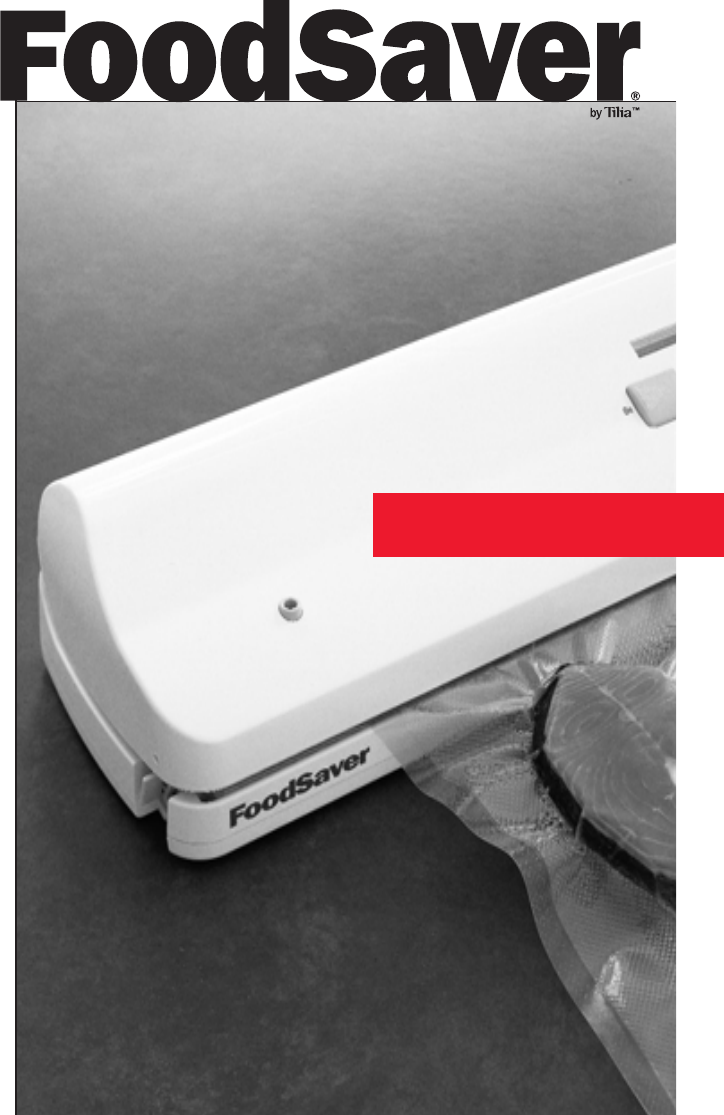
©2000 by Tilia, Inc. All Rights Reserved.
This material may not be copied or reproduced in any
fashion without written permission from the publisher.
FoodSaver®is a registered trademark of Tilia, Inc.
First printing, August 2000
Printed in the United States of America
FoodSaver Patent 4,941,310
FoodSaver Bag Patent RE: 34,929
Item# 18-0509 (10/00)
User Manual
The Original Home Vacuum Packaging System
™
Vac 1050

Welcome
THE FOODSAVER USER MANUAL
You have just purchased an appliance that will soon
have you wondering how you ever got by without
it. The FoodSaver Vac 1050 is so convenient and
versatile, you’ll find yourself using it every day. We
guarantee that if you make room for it on your
countertop, you will quickly see how indispensable
it becomes in your kitchen.
Foods Will Keep Their “Just Bought” Freshness,
Flavor, and Nutritional Value 3 to 5 Times Longer.
◗Meats, poultry, fish, and produce stay fresh and
flavorful in your freezer.
◗No more freezer burn.
◗Foods stay fresh longer in your refrigerator.
◗Dry ingredients stay fresh and insect-free in
the pantry.
You’ll Save Money, Time, and Effort.
◗Buy in bulk to reduce your grocery bills.
◗Repackage your purchases in portions sized for
your family’s needs.
◗Prepare meals in advance so when you don’t have
time to cook, you and your family will still have
great-tasting homemade meals.
◗Take bags right from the freezer or refrigerator
and boil or microwave.
◗Reduce waste and spoilage.
◗Prepare your own healthy frozen dinners. You
control serving portions, calories, and nutritional
content.
◗Make and deliver home-cooked meals to those
who can’t get out.
◗Keep non-food items dry and free of dust and mold.
◗Stop silver from tarnishing because the metal is
not exposed to air.
Table of Contents
THE FOODSAVER USER MANUAL
1
Welcome
2The FoodSaver Vac 1050
4FoodSaver Accessories
Operating Instructions: How to...
6Make a Custom-Made Bag with FoodSaver Rolls
8Vacuum Package Using Ready-Made and
Custom-Made FoodSaver Bags
10 Use the Sealing Time Switch
11 Use the Manual Seal Button
14 Vacuum Package Using FoodSaver Designer Canisters
16 Vacuum Package Using FoodSaver Bulk Storage and
Square Canisters
18 Vacuum Package Using the FoodSaver Jar Sealer with Mason Jars
20 Vacuum Package Using FoodSaver Universal Lids
22 Vacuum Package Using FoodSaver Bottle Stoppers
24 Care and Cleaning Instructions
25 Food Preparation and Storage Guide
34 Important Safeguards
35 Troubleshooting
38 Marinating Recipes
43 Vacuum Packaging Non-Food Items
44 Warranty and Service Information
...to the world of FoodSaver.
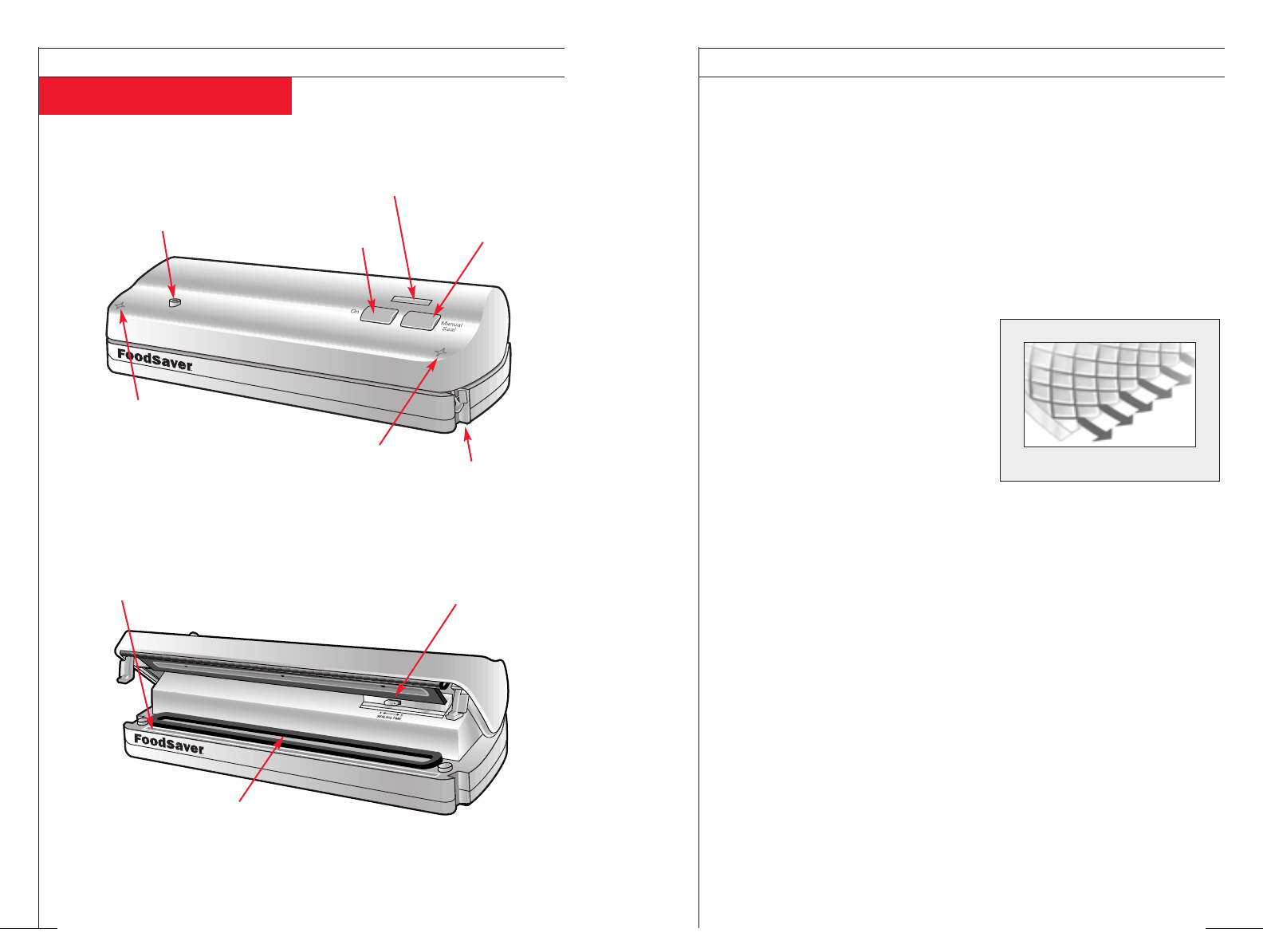
THE FOODSAVER USER MANUAL
3
About Vacuum Packaging
Air is left in most food storage con-
tainers and plastic bags even when
they are sealed tightly. Oxygen is
one of the main reasons that food
goes bad. It starts a chemical
change – robbing food of its nutri-
tional value, texture, color, flavor,
and overall quality. The FoodSaver
Vac 1050 removes the air from our
FoodSaver Bags and then seals the
bags so that air cannot reenter. The
Vac 1050 is also designed to be used
with a wide range of FoodSaver
accessories that will keep a variety
of foods fresh longer. Finally, you
can maintain the same freshness at
home that you get with profession-
ally vacuum-packaged items you
purchase at the grocery store.
FoodSaver Bags and Rolls
◗FoodSaver Bags and Rolls are made
from a patented, 3-ply plastic
material with special channels that
remove the air. The outer layer
of nylon seals freshness in, while
locking air and moisture out.
◗FoodSaver Bags and Rolls can go
straight from the freezer and
refrigerator to the microwave or
boiling water. They are reusable,
washable (including in the dish-
washer), and recyclable.
◗FoodSaver Bags are ready-made
in quart and gallon sizes to offer
convenient, one-step storage.
◗FoodSaver Rolls come in two
widths, 8 inches and 11 inches,
which allow you to make custom-
sized bags for the items that you
are vacuum packaging.
◗Most FoodSaver users like to keep
both bags and rolls handy for the
greatest packaging convenience.
Our Patented 3-Layer Design
Patented FoodSaver Bags are designed to
remove air and seal in freshness.
The FoodSaver Vac 1050
THE FOODSAVER USER MANUAL
2
Vac 1050
Vac 1050
Sealing Strip
Vacuum
Channel
Sealing
Time Switch
On Button
Sealing Lights
Star
Lock: There is
a lock on each
side.
Vacuum
Hose Port Manual
Seal Button
Star
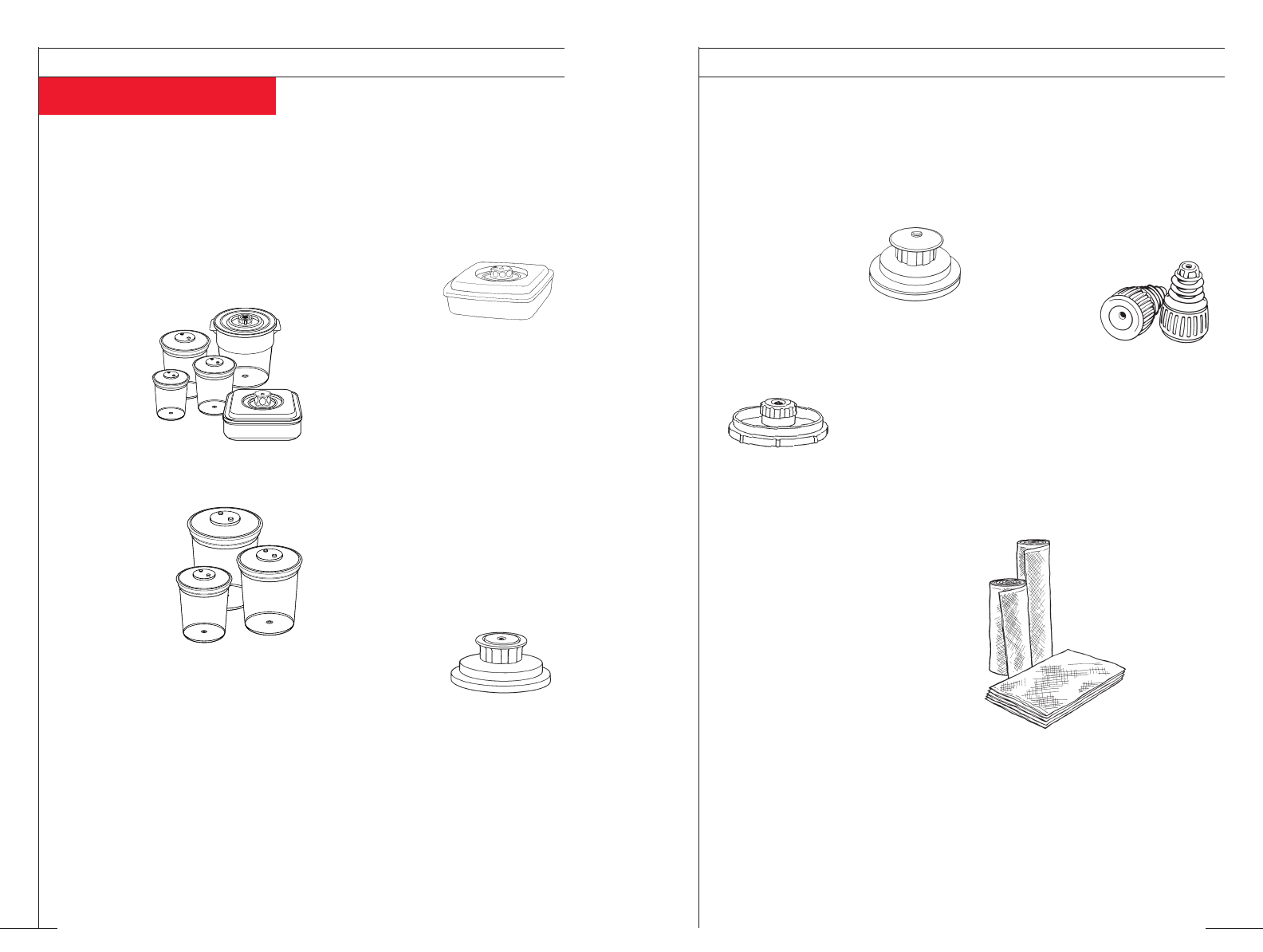
FoodSaver Accessories
THE FOODSAVER USER MANUAL
4
FoodSaver Canisters
◗There are three styles of FoodSaver
Canisters – Designer, Square, and
Bulk Storage. They are ideal for
storing delicate items and liquids,
as well as dry goods and cooking
staples. The
Canisters
come in a
variety of
sizes and
all can be
used in the refrigerator
and pantry. Canisters are not to
be used in the freezer.
◗FoodSaver
Designer
Canisters are
especially
attractive for
use on your
countertop.
◗Vacuum packaging in the
FoodSaver Square Canister is an
excellent way to marinate foods
because the process opens the
pores of the
food and seals
in the flavor.
The Vac 1050
can marinate food in 20 minutes
so you don’t have to wait all day
or overnight for that special taste.
All FoodSaver Canisters work for
marinating, but we recommend
the Square Canister because less
marinade will be needed.
◗The Bulk Storage Canisters are
designed to store pantry items
such as cereal, chips, rice, and
baking goods.
FoodSaver Regular Jar Sealer
◗The FoodSaver
Regular Jar
Sealer allows
you to vacuum
package in regular or standard
mouth mason jars.
Note: FoodSaver Jar Sealers are
designed to fit mason jars manu-
factured in the U.S., such as Ball®
and Kerr®brands.
THE FOODSAVER USER MANUAL
5
FoodSaver Wide-Mouth Jar Sealer
◗The FoodSaver Wide-Mouth Jar
Sealer allows you to
vacuum package
in wide-mouth
mason jars.
FoodSaver Universal Lids
◗With this great kitchen accessory,
you don’t have to transfer many
foods out of their
original containers.
Vacuum package
and extend the life of foods in their
original glass jars and metal cans.
◗Available in two sizes – 4 inches
and 51⁄2inches in diameter.
FoodSaver Bottle Stoppers
◗FoodSaver Bottle Stoppers allow
you to vacuum package bottles
to protect the taste and
extend the life of liquids
such as wine,
liquor, and
cooking oils.
Purchasing FoodSaver Bags,
Rolls, and FoodSaver Accessories
◗Your Vac 1050 kit includes
FoodSaver Bags and Rolls and
may include some accessories.
Additional supplies and acces-
sories are available at your local
retailer. To find the nearest one,
visit our website at
www.foodsaver.com
or call our Consumer
Services Department at
the number listed at
the back of
this manual.
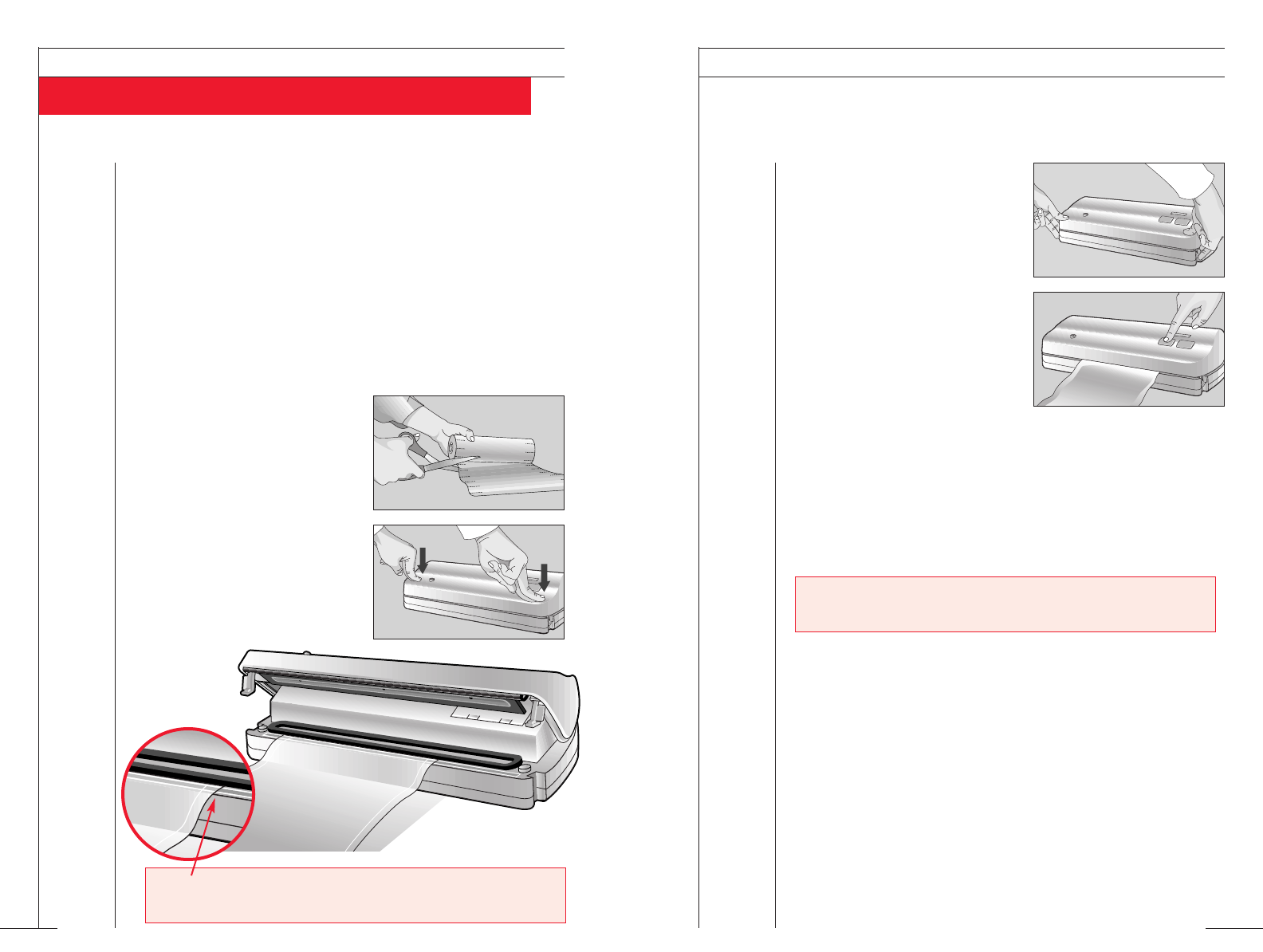
THE FOODSAVER USER MANUAL
7
6Close the lid.
7Lock the lid by pulling the locks
forward on both sides until they
snap into place. (You may need
to press down lightly on the stars
while pulling the locks forward.)
8Press and release the On button.
The lights will turn on in sequence
as the Vac 1050 seals the bag.
9The sound will stop and the lights
will turn off when the bag is sealed. The locks on the sides will
release automatically. Lift up the lid and remove the bag.
10 You now have a custom-sized FoodSaver Bag.
You are now ready to vacuum package. Just follow the instructions
on page 9.
NOTE: Let the Vac 1050 cool down for at least 20 seconds
before using it again.
How to Make a Custom-Made Bag with FoodSaver Rolls
THE FOODSAVER USER MANUAL
6
When using FoodSaver Rolls you first need to make a bag, then
vacuum package your food in the bag. (If you are using ready-
made FoodSaver Bags, go to page 9.)
1Place the Vac 1050 on a flat, dry surface and plug the power cord
into a standard electrical outlet.
2Lay the item(s) you want to vacuum package near the FoodSaver
Roll so you can see where to cut the bag material. Leave at least 3
extra inches at one end of the bag and more if you want to reseal
or reuse the bag. (One inch per reseal.)
3Cut the FoodSaver Roll to the
desired length, making sure you
cut straight. The marks on the side
of the roll are at 3" intervals and
will assist you in cutting straight.
4Open the lid of the Vac 1050. If
the lid is locked, release the locks by
pressing down firmly on the stars.
5Place one end of the bag on the
sealing strip.
IMPORTANT: Make sure the end does not go over the black foam
rubber ring, or into the vacuum channel.
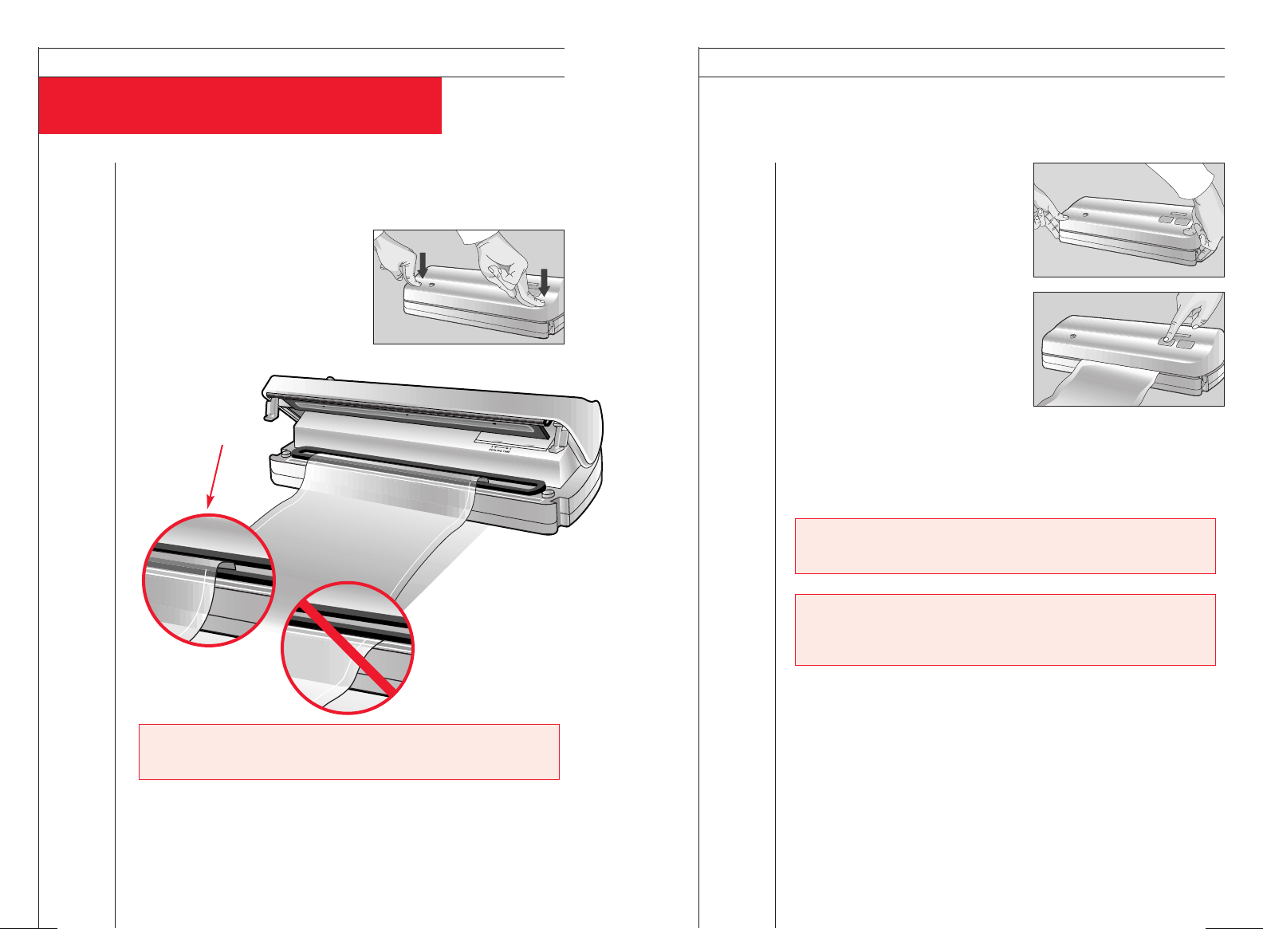
THE FOODSAVER USER MANUAL
9
6Lock the lid by pulling the locks
forward on both sides until they
snap into place. (You may need
to press down lightly on the stars
while pulling the locks forward.)
7Press and release the On button.
The lights will turn on in sequence
as the Vac 1050 vacuums and seals
the bag.
8The sound will stop and the lights
will turn off when the bag is sealed.
The locks on the sides will release automatically. Lift up the lid
and remove the bag.
9Vacuum packaging is complete.
IMPORTANT: You will need to pre-freeze foods that have excess
liquid or moisture before vacuum packaging in FoodSaver Bags
because the liquid can be drawn up into the vacuum pump.
NOTE: Let the Vac 1050 cool down for at least 20 seconds before
using it again.
How to Vacuum Package Using Ready-Made
and Custom-Made FoodSaver Bags
THE FOODSAVER USER MANUAL
8
1If you have not already done so, place the Vac 1050 on a flat, dry
surface and plug the power cord into a standard electrical outlet.
2Open the lid. If the lid is locked,
release the locks by pressing down
firmly on the stars.
3Place the item(s) to be vacuum
packaged into the bag.
4Place the open
end of the bag
down into the
vacuum channel.
5Close the lid.
IMPORTANT: Make sure the open end of the bag touches the blue
label on the bottom of the vacuum channel.
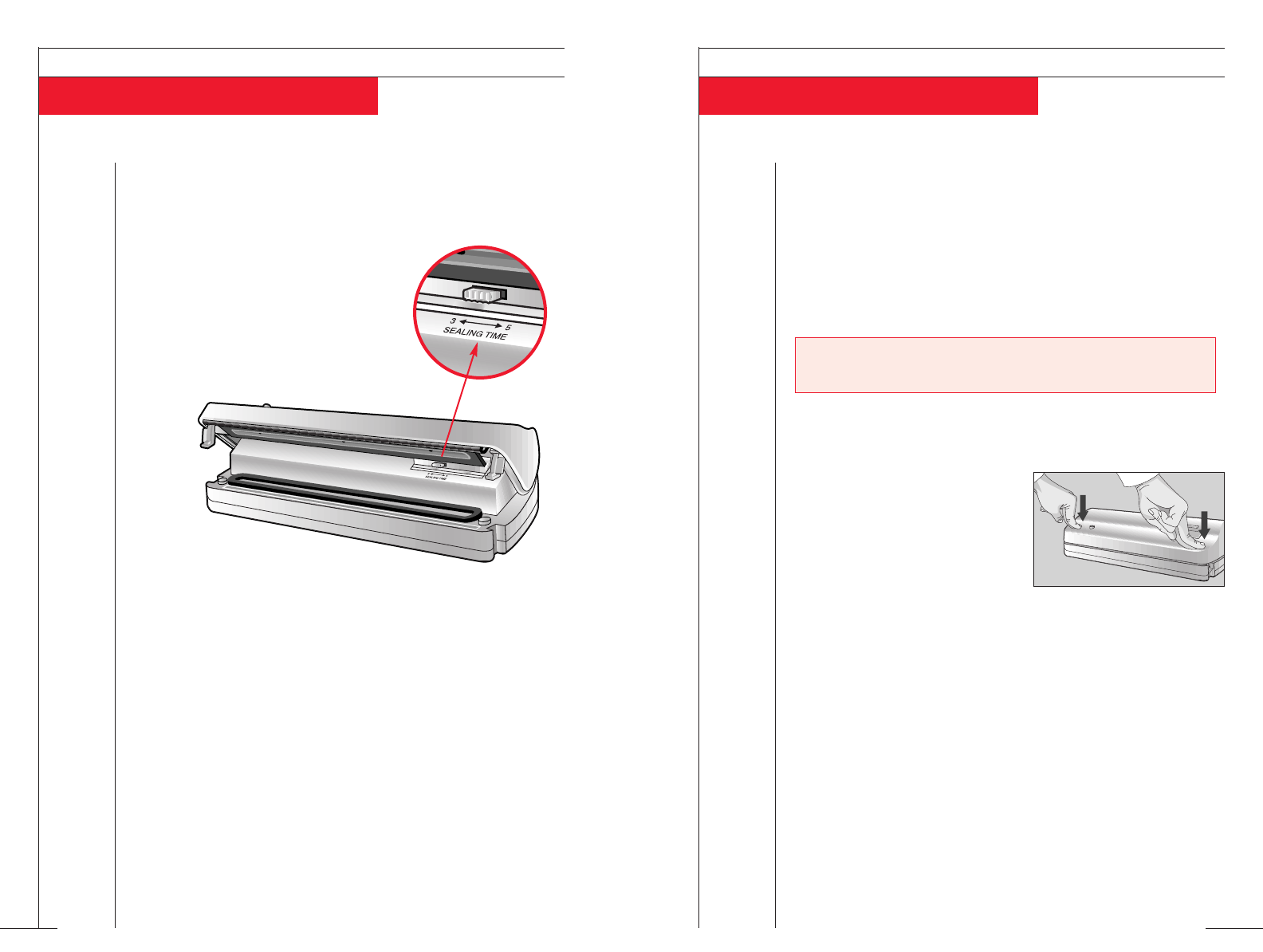
How to Use the Manual Seal Button
THE FOODSAVER USER MANUAL
11
When to Use the Manual Seal Button
Use the Manual Seal Button when you want to seal a VacLoc
Bag before a complete vacuum has been created in the bag. This
feature is useful when vacuum packaging fragile items such as
bread, baked goods and berries so they don’t get crushed.
How to Use the Manual Seal Button
1If you have not already done so, place the Vac 1050 on a flat, dry
surface and plug the power cord into a standard electrical outlet.
2Open the lid. If the lid is locked,
release the locks by pressing down
firmly on the stars.
3Place the item(s) to be vacuum
packaged into the bag.
NOTE: If using a VacLoc Roll, you will need to create a bag first.
Refer to instructions on page 6.
How to Use the Sealing Time Switch
THE FOODSAVER USER MANUAL
10
Sealing Time Switch
This two-position switch lets you control the length of the sealing
process. It can be set for 3 or 5 seconds. Set at 3 seconds for
normal vacuum packaging. Set at 5 seconds
when vacuum packaging foods with excess
moisture and juices.
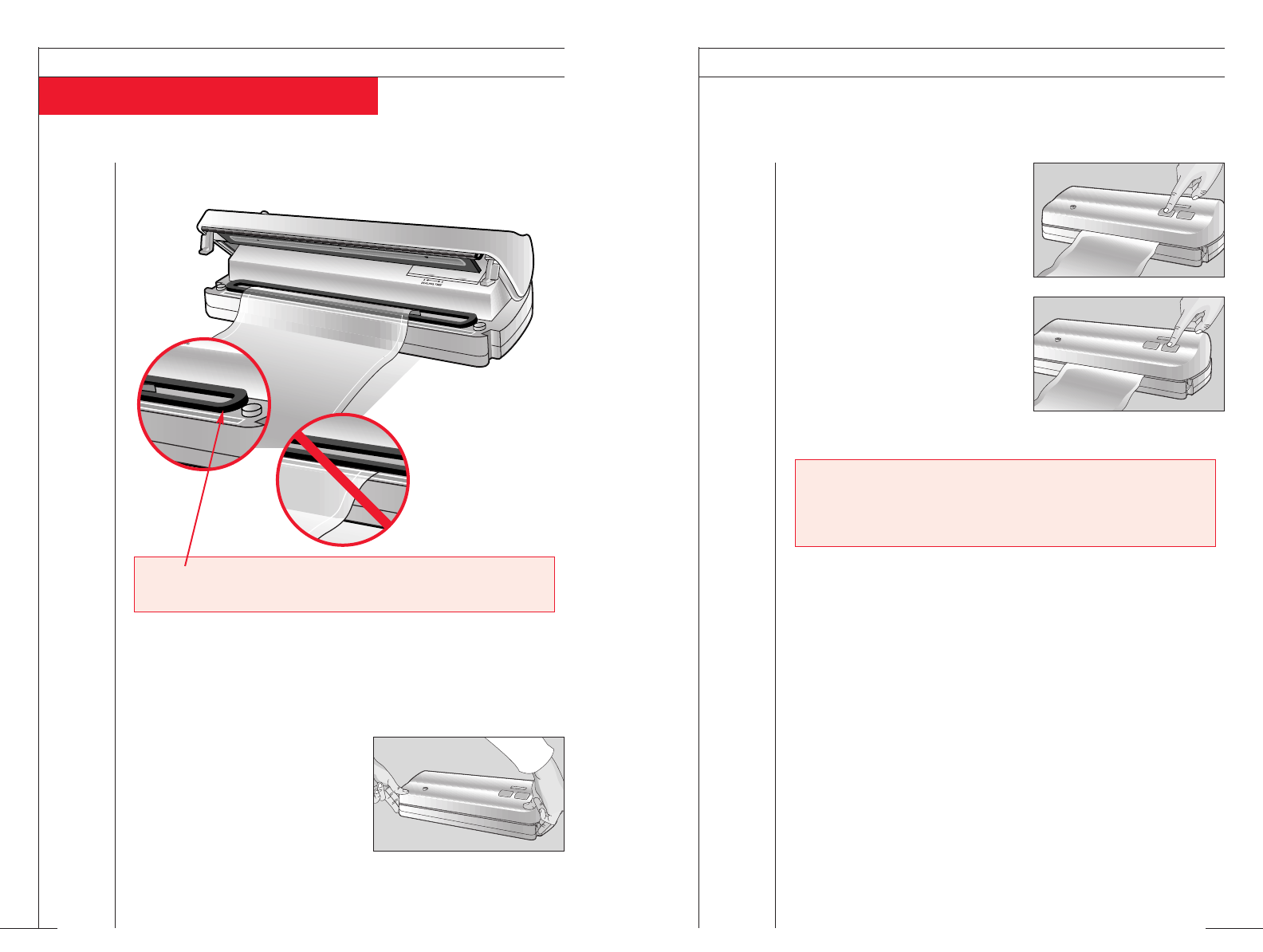
THE FOODSAVER USER MANUAL
13
7Press and release the On button.
The lights will turn on in sequence
as the Vac 1050 vacuums the bag.
8To stop the vacuum process before
all the air is removed, press and
release the Manual Seal Button.
The sound will stop and the lights
will turn off when bag is sealed.
The locks on the sides will release
automatically. Lift up the lid and
remove the bag.
9Vacuum packaging is complete.
NOTE: It takes approximately three seconds to stop the vacuum
process and seal the bag. If you are using a small bag or pack-
aging a fragile item, we recommend that you press down on the
Manual Seal Button immediately after pressing the On button.
How to Use the Manual Seal Button
THE FOODSAVER USER MANUAL
12
4Place the open end of the bag down into the vacuum channel.
5Close the lid.
6Lock the lid by pulling the locks forward on both sides until they
snap into place. (You may need to press down lightly on the stars
while pulling the locks forward.)
IMPORTANT: Make sure the open end of the bag touches the blue
label on the bottom of the vacuum channel.
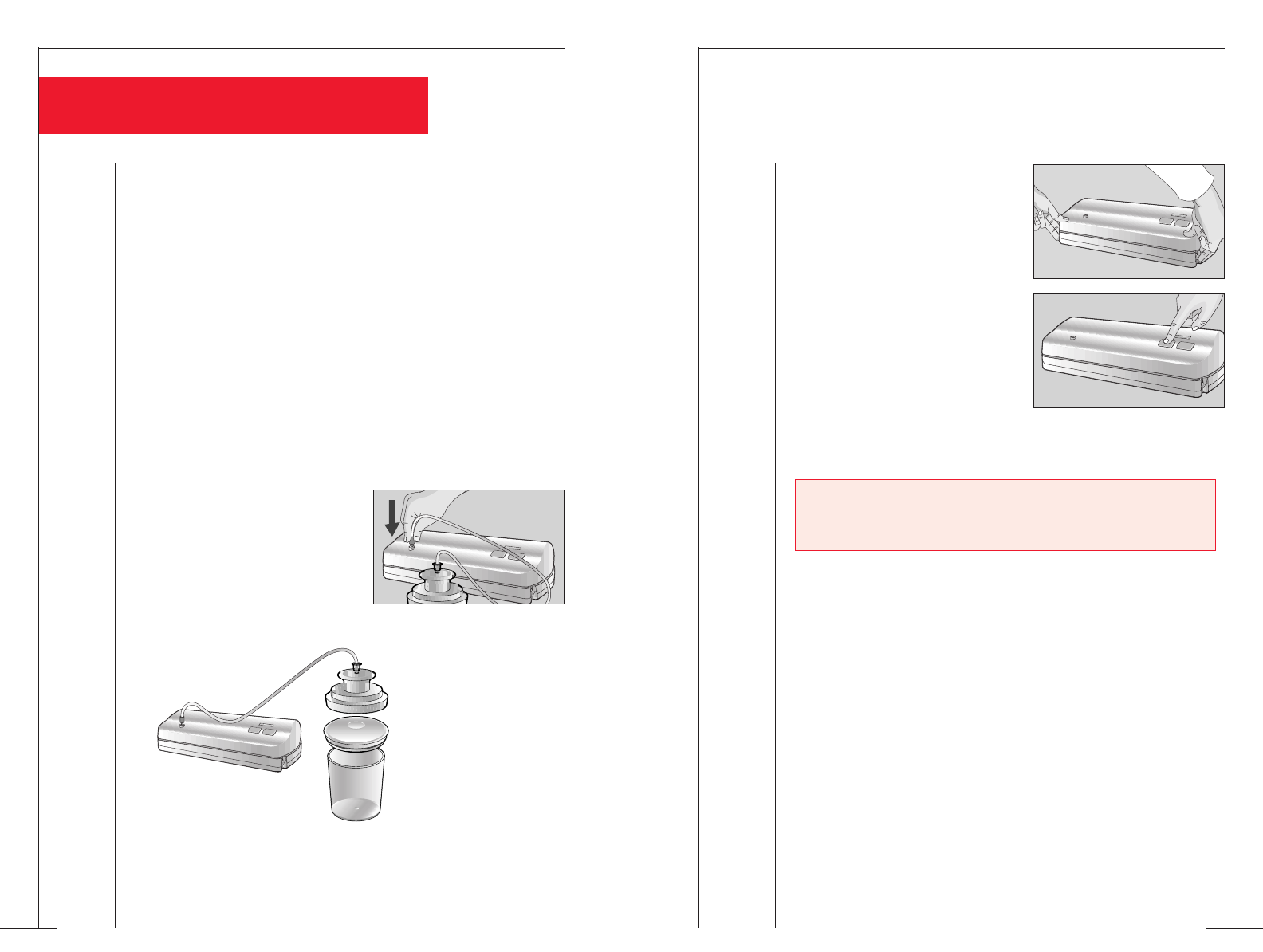
THE FOODSAVER USER MANUAL
15
6Lock the lid by pulling the locks
forward on both sides until they
snap into place. (You may need to
press down lightly on the stars
while pulling the locks forward.)
7Press and release the On button.
The lights will turn on in sequence
as the Vac 1050 starts the vacuum
cycle and air is removed from the
canister. The sound will stop and
the lights will turn off when
vacuum packaging is complete.
8Vacuum packaging is complete.
How to Open the FoodSaver Designer Canister
To open the FoodSaver Designer Canister, press and hold down
the grey rubber button in the center of the lid. This will release
the vacuum and you should be able to remove the lid.
IMPORTANT: Remember to remove the accessory hose from the
accessory port on the FoodSaver Vac 1050 before you vacuum
package in FoodSaver Bags.
How to Vacuum Package Using FoodSaver
Designer Canisters
THE FOODSAVER USER MANUAL
14
FoodSaver Designer Canisters are both functional and attractive
and an excellent way to store delicate items in the refrigerator,
pantry, or on the countertop. FoodSaver Designer Canisters
cannot be stored in the freezer, and unlike the Bulk Storage and
Square Canisters, cannot be used in the microwave. The bases
can be put in the dishwasher for cleaning. However, do not put
the lids in the dishwasher.
1Place the Vac 1050 on a flat, dry surface and plug the power cord
into a standard electrical outlet.
2Place the item(s) to be vacuum packaged inside the canister. Leave
at least one inch between the contents and the rim of the canister.
3Place the lid on top of the canister.
4Insert one end of the accessory
hose into the accessory port on
the Vac 1050.
5Insert the other end of the accessory
hose into the hole on the top of
the canister.
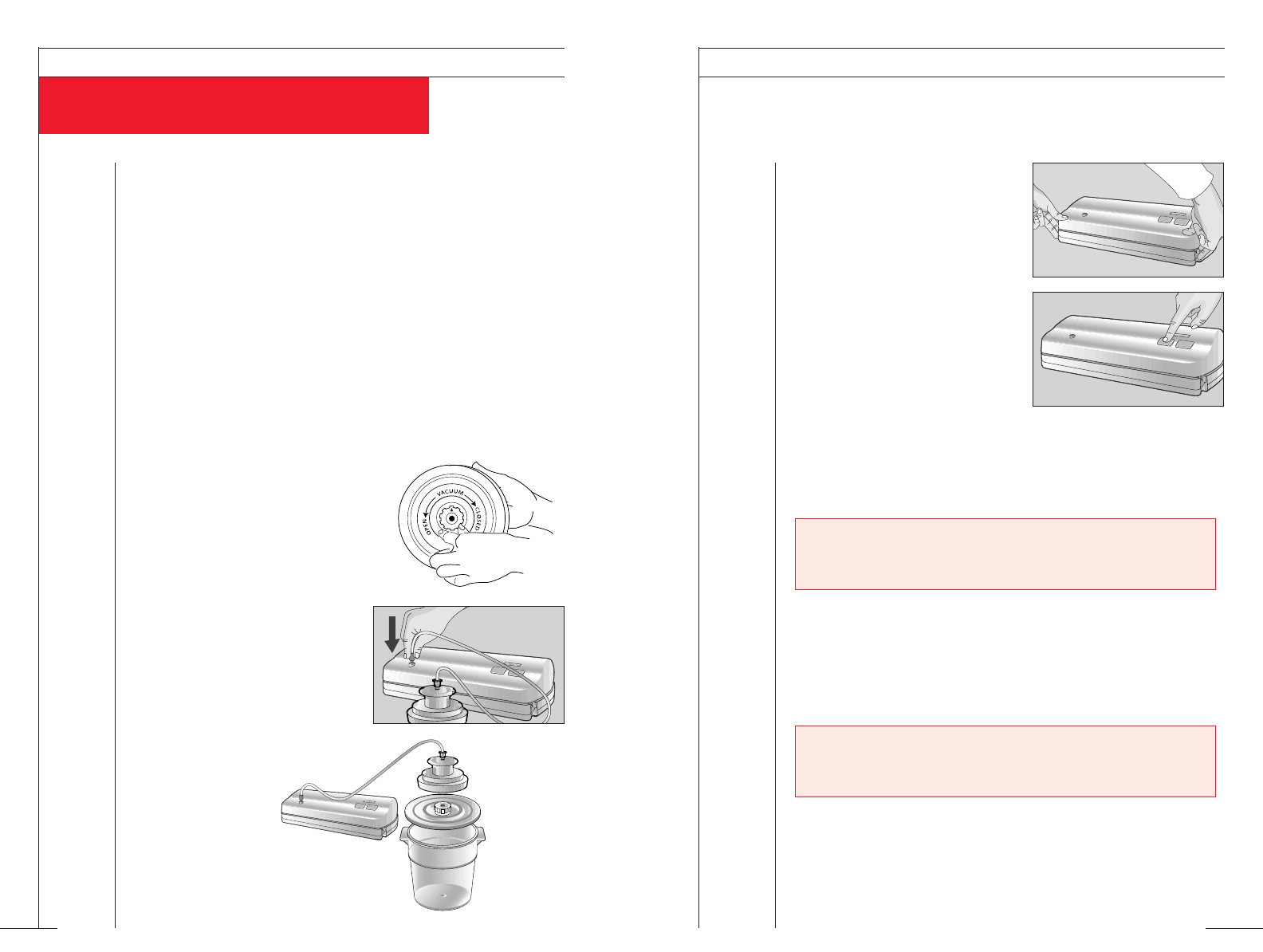
How to Vacuum Package Using FoodSaver
Bulk Storage and Square Canisters
THE FOODSAVER USER MANUAL
16
THE FOODSAVER USER MANUAL
17
7Lock the lid by pulling the locks
forward on both sides until they
snap into place. (You may need to
press down lightly on the stars
while pulling the locks forward.)
8Press and release the On button.
The lights will turn on in sequence
as the Vac 1050 starts the vacuum
cycle and air is removed from the
canister. The sound will stop and
the lights will turn off when
vacuum packaging is complete.
9Turn the knob on the canister lid so the arrow points to “Closed.”
10 Vacuum packaging is complete.
How to Open the FoodSaver Bulk Storage or Square Canister
To open the FoodSaver Bulk Storage or Square Canister, turn the
knob on the canister lid so the arrow points to “Open.” This will
release the vacuum and you should be able to remove the lid.
NOTE: Do NOT attempt to vacuum seal any contents that are
warmer than room temperature, since the vacuum may cause
the contents to bubble out of the canister or jar.
IMPORTANT: Remember to remove the accessory hose from the
accessory port on the Vac 1050 before you vacuum package in
FoodSaver Bags.
FoodSaver Bulk Storage and Square Canisters are a great way to
store food in your refrigerator and pantry. The Square Canister is
also ideal for marinating.
FoodSaver Canisters cannot be stored in the freezer. The Bulk
Storage and Square Canister bases can be used in the microwave
to reheat foods and put in the dishwasher for cleaning. Do not
put the lids in the microwave or dishwasher.
1Place the Vac 1050 on a flat, dry surface and plug the power cord
into a standard electrical outlet.
2Place the item(s) to be vacuum packaged inside the canister. Leave
at least one inch between the contents and the rim of the canister.
3The canister lid is labeled “Open,”
“Vacuum,” and “Closed.” Turn the
knob on the canister lid so the arrow
points to “Vacuum.”
4Place the lid on top of the canister.
5Insert one end of the accessory
hose into the accessory port on the
Vac 1050.
6Insert the other end of the acces-
sory hose into the hole on the top
of the canister.
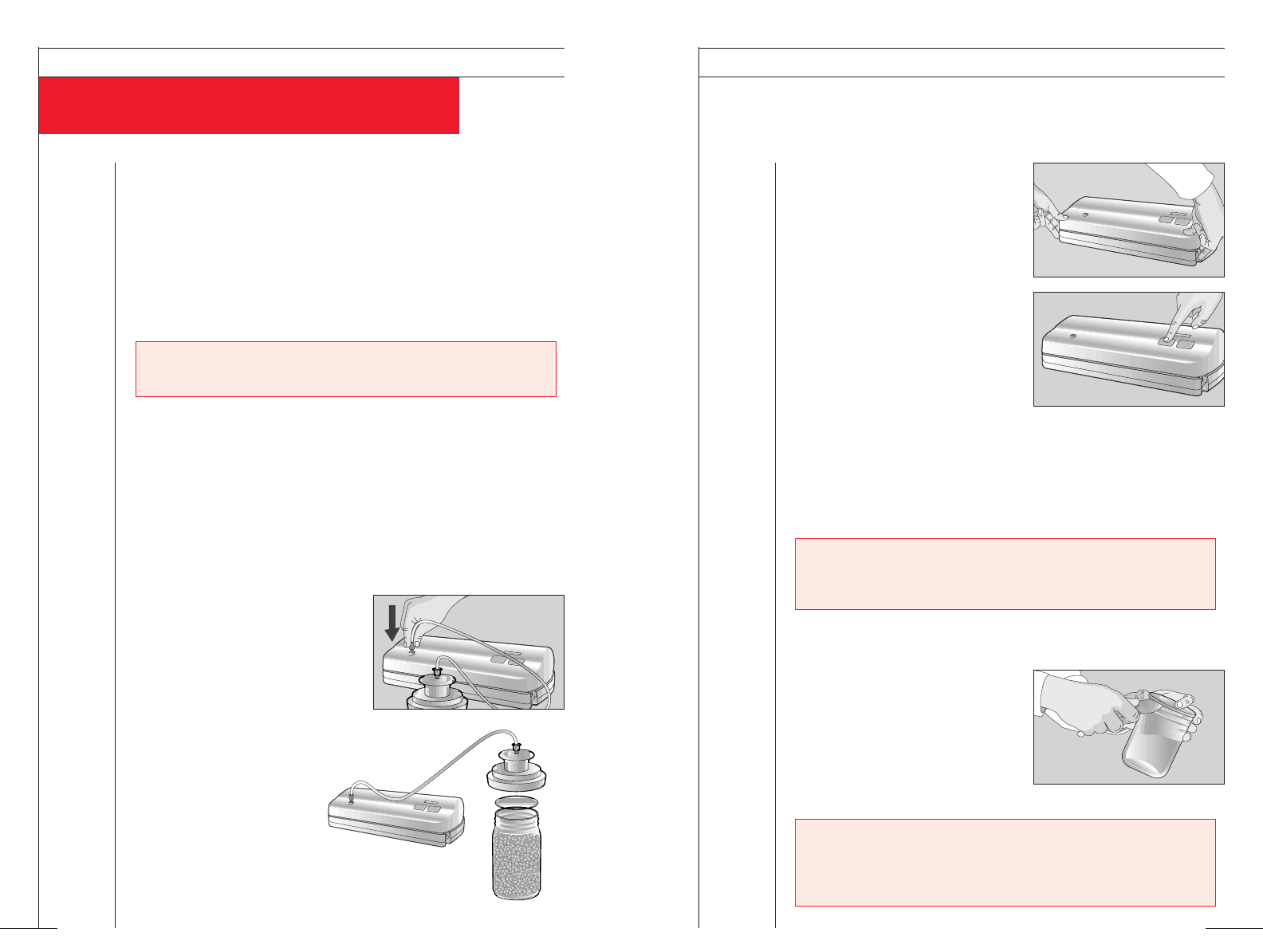
THE FOODSAVER USER MANUAL
19
How To Vacuum Package Using the FoodSaver
Jar Sealer with Mason Jars
THE FOODSAVER USER MANUAL
18
7Lock the lid by pulling the locks
forward on both sides until they
snap into place. (You may need to
press down lightly on the stars
while pulling the locks forward.)
8Press and release the On button.
The lights will turn on in sequence
as the Vac 1050 starts the vacuum
cycle and air is removed from the
Mason Jar. The sound will stop
and the lights will turn off when
vacuum packaging is complete.
9Gently pull up on the jar sealer to remove it. The metal lid should
fit tightly on the jar; you should not be able to pull it off.
10 Vacuum packaging is complete.
How to Open the Mason Jar
To open the mason jar, wedge a
spoon between the mason jar lid
and the highest part of the threaded
rim. Twist the spoon gently to
release the vacuum. When opened
this way, the mason jar lid can be
reused many times.
IMPORTANT: To avoid accidents, do not use a knife to remove
the mason jar lid. Also, do not use a bottle opener to remove the
mason jar lid as it will bend the lid and prevent its reuse. Vacuum
packaging with the Vac 1050 is not a substitute for canning.
IMPORTANT: Remember to remove the accessory hose from the
accessory port on the Vac 1050 before you vacuum package in
FoodSaver Bags.
The Vac 1050 used with the FoodSaver Jar Sealer allows you to
vacuum package food in mason jars. There are two sizes of jar
sealers: the FoodSaver Wide-Mouth Jar Sealer for wide-mouth
mason jars, and the FoodSaver Regular Jar Sealer for regular and
standard-mouth mason jars. If you wish to store mason jars in
the freezer, make sure to use tapered and tempered freezer-safe
mason jars and leave extra space between the contents and the
lid to allow for the normal expansion of liquids.
1Place the Vac 1050 on a flat, dry surface and plug the power cord
into a standard electrical outlet.
2Place the item(s) to be vacuum packaged inside the mason jar.
Leave at least one inch between the contents and the rim of the jar.
3Place the mason jar lid on the top of the mason jar. (You will not
need the screw band section of the mason jar lid. It is not used
when vacuum packaging.)
4Insert one end of the accessory
hose into the hose port on the
Vac 1050.
5Insert the other end of the
accessory hose into the hole
on the top of the jar sealer.
6Place the jar sealer over the
top of the mason jar. Push
down firmly until the jar
sealer covers the entire
rim of the jar.
NOTE: Always pre-soak new metal lids. Bring water to a boil, then
turn off. Pre-soak lids 5-10 minutes.
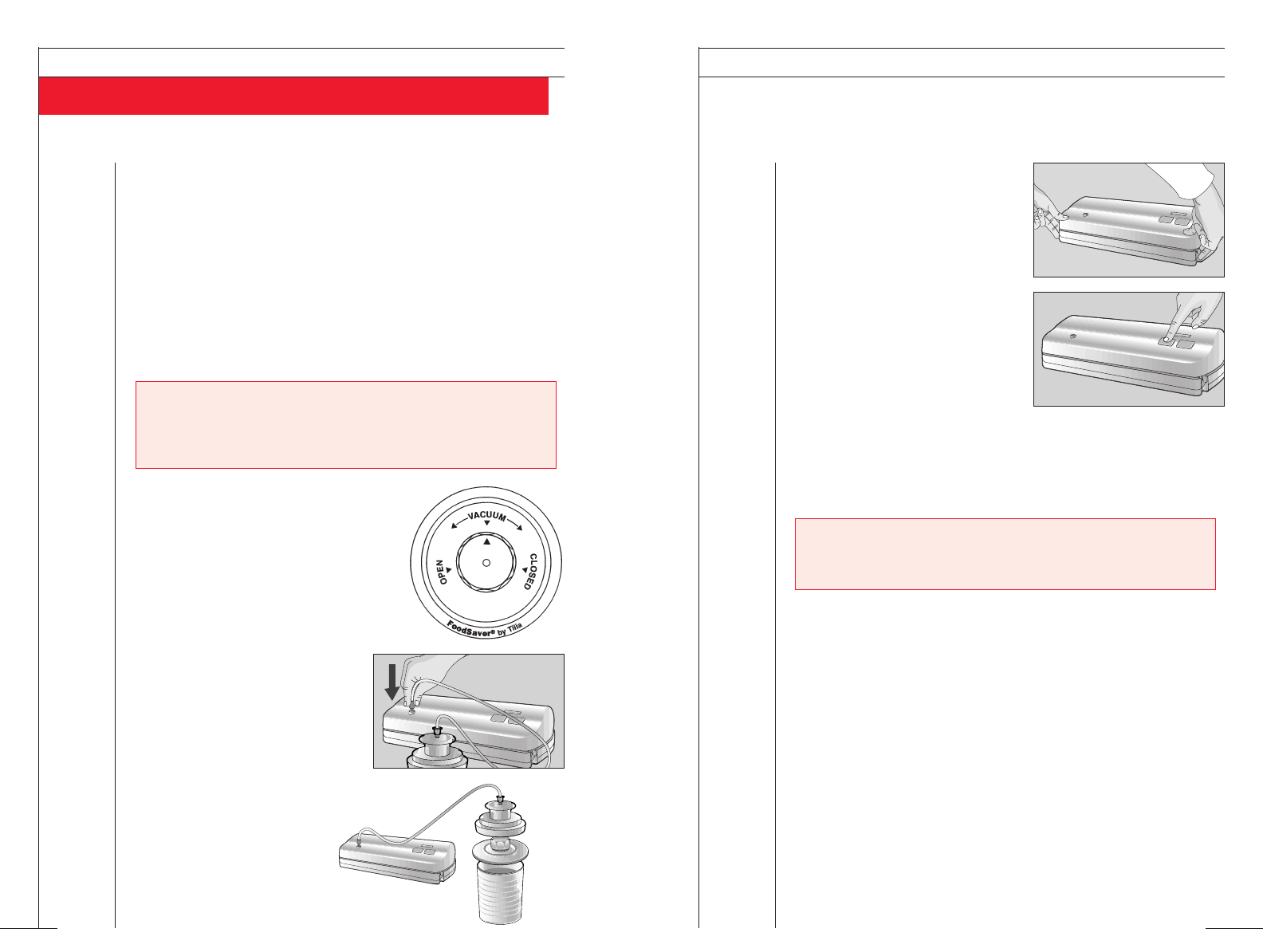
THE FOODSAVER USER MANUAL
21
6Lock the lid by pulling the locks
forward on both sides until they
snap into place. (You may need to
press down lightly on the stars
while pulling the locks forward.)
7Press and release the On button.
The lights will turn on in sequence
as the Vac 1050 starts the vacuum
cycle and air is removed from the
container. The sound will stop and
the lights will turn off when
vacuum packaging is complete.
8Turn the knob on the universal lid so the arrow points to “Closed.”
9Vacuum packaging is complete.
How to Open the FoodSaver Universal Lid
To open the FoodSaver Universal Lid, turn the knob so the arrow
points to “Open.” You should now be able to remove the univer-
sal lid from the container.
IMPORTANT: Remember to remove the accessory hose from the
accessory port on the FoodSaver Vac 1050 before you vacuum
package in FoodSaver Bags.
How To Vacuum Package Using FoodSaver Universal Lids
THE FOODSAVER USER MANUAL
20
FoodSaver Universal Lids give you the flexibility of vacuum
packaging some foods in their original containers. They work on
most metal cans and glass jars. They’re excellent for retaining the
freshness of tomato and pasta sauces, coffee, mustards, and toppings.
However, vacuum packaged canned foods still must be refrigerated
to minimize micro-organism growth. If you are planning to store
canned foods for more than a day, transferring foods from the can
into a FoodSaver Bag, FoodSaver Canister, a glass, or a hard plastic
container is recommended to prevent “off-flavor” from developing
from the can.
1Place the Vac 1050 on a flat, dry surface
and plug the power cord into a standard
electrical outlet.
2The universal lid is labeled “Open,”
“Vacuum,” and “Closed.” Turn the knob
on the universal lid so the arrow points to
“Vacuum.”
3Place the universal lid on top of
the open container.
4Insert one end of the accessory
hose into the accessory port
on the Vac 1050.
5Insert the other end of the
accessory hose into the
hole on the top of the
universal lid.
CAUTION: FoodSaver Universal Lids are not to be used with thin
glass, crystal, plastic, or aluminum containers. The vacuum
force exerted by the Vac 1050 is very powerful and could implode
a thin glass or a non-rigid container.
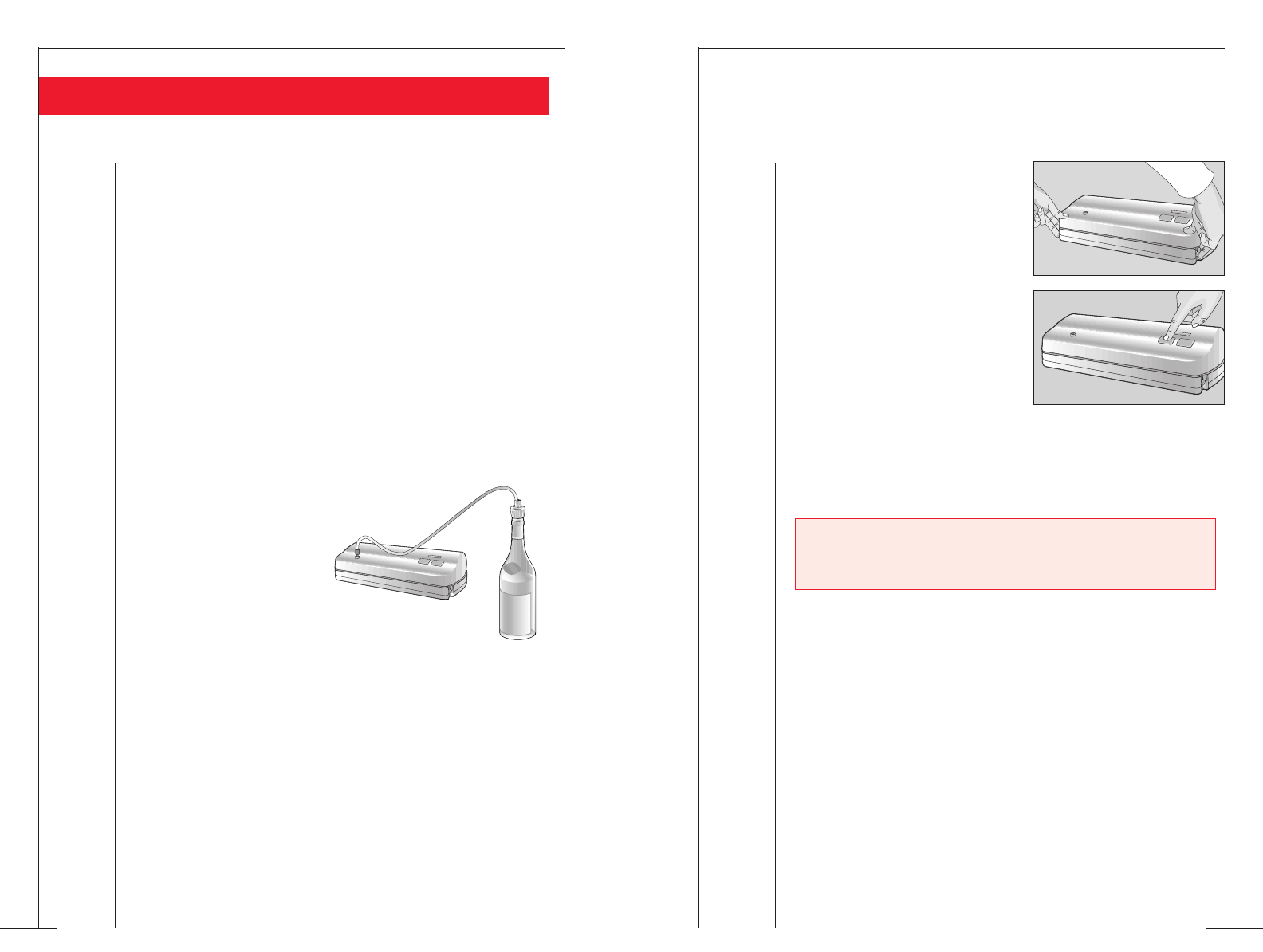
THE FOODSAVER USER MANUAL
23
How to Vacuum Package Using FoodSaver Bottle Stoppers
THE FOODSAVER USER MANUAL
22
5Lock the lid by pulling the locks
forward on both sides until they
snap into place. (You may need to
press down lightly on the stars
while pulling the locks forward.)
6Press and release the On button.
The lights will turn on in sequence
as the Vac 1050 starts the vacuum
cycle and air is removed from the
bottle. The sound will stop and the
lights will turn off when vacuum
packaging is complete.
7Remove the accessory hose from the bottle stopper.
8Vacuum packaging is complete.
How to Remove the FoodSaver Bottle Stopper
To remove the FoodSaver Bottle Stopper, simply twist and pull
up on the bottle stopper to release the vacuum.
IMPORTANT: Remember to remove the accessory hose from the
accessory port on the Vac 1050 before you vacuum package in
FoodSaver Bags.
FoodSaver Bottle Stoppers are the best way to keep wine, oils, and
non-carbonated bottled liquids fresh longer. You will keep their
delicate taste from going stale by not exposing the liquids to air.
FoodSaver Bottle Stoppers are not to be used with plastic bottles.
Also, do not use with any carbonated or sparkling beverages.
Carbonation happens under pressure. A vacuum removes this
pressure, releasing the bubbles and causing the beverages to
become flat.
1Place the Vac 1050 on a flat, dry surface and plug the power cord
into a standard electrical outlet.
2Insert the bottle stopper into the neck of the bottle. Leave at
least one inch between the contents and the bottom of the
bottle stopper.
3Insert one end of the acces-
sory hose into the accessory
port on the Vac 1050.
4Insert the other end of the
accessory hose into the hole on
the top of the bottle stopper.
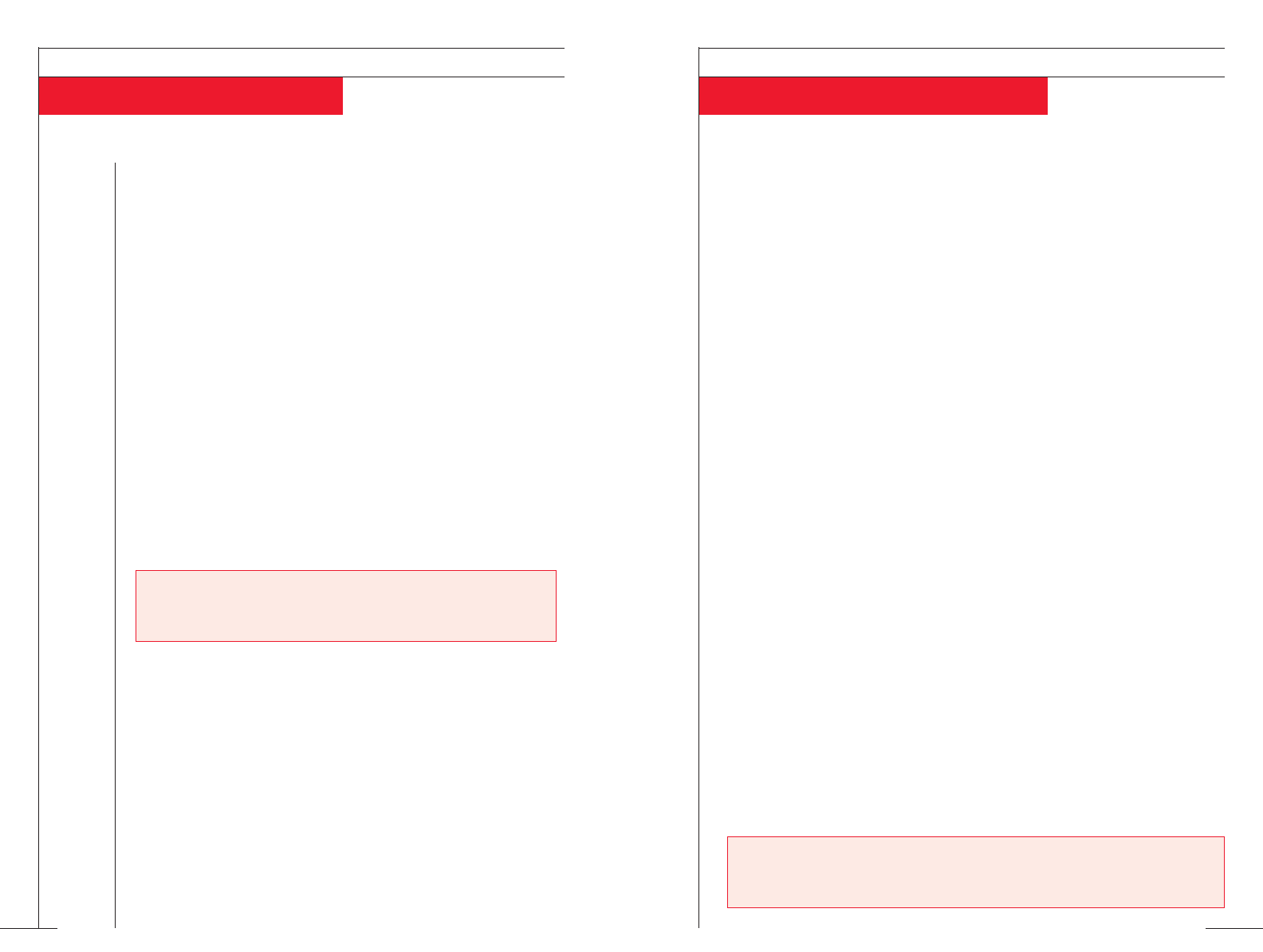
Food Preparation and Storage Guide
THE FOODSAVER USER MANUAL
25
Care and Cleaning Instructions
THE FOODSAVER USER MANUAL
24
The FoodSaver Vac 1050
1Always unplug the Vac 1050 before cleaning.
2Do not immerse the Vac 1050 in water.
3Do not use abrasive products or materials to clean any of the Vac
1050 components. Such cleaners can scratch the surfaces and damage
the black foam rubber pads, preventing a vacuum from forming.
4Clean using a mild dishwashing soap and a warm, damp cloth.
Wipe away any food residue from inside or around the vacuum
channel, sealing strip, and black foam rubber pads.
5Dry thoroughly before using.
FoodSaver Bags
1Wash bags in warm water using a mild dishwashing soap.
2Bags can be washed in the dishwasher by carefully turning the
bags inside out and spreading them over the top rack of the dish-
washer, so that all surfaces are exposed to the washing water.
3Allow bags to dry thoroughly before reusing.
FoodSaver Accessories
1All FoodSaver accessories should be washed in warm water using
a mild dishwashing soap.
2Dry thoroughly before using.
3All FoodSaver Canister bases (but not the lids) may be washed in
the dishwasher.
4Square and Bulk Storage Canister bases (but not the lids) may be
used to reheat foods in the microwave.
5Designer Canister bases and lids are not to be used in the
microwave.
IMPORTANT: We do not recommend reusing bags that have been
used to store raw meats or fish. Also, bags may not be reusable
if they have been used to store greasy or fatty foods.
NOTE: Vacuum packaging is NOT a substitute for refrigeration or freezing.
Any perishable foods that require refrigeration prior to vacuum packaging
still must be refrigerated or frozen after vacuum packaging.
Guidelines for Vacuum
Packaging Food
Vacuum packaging is not a substitute
for canning nor can it reverse deteri-
orating quality; it can only slow down
changes in quality. It is impossible to
predict how long a specific food will
have top-quality flavor, appearance,
and texture, because it depends on
the age and condition of the food
on the day it was vacuum packaged.
Foods that are extremely fresh will
last longer than foods that are al-
ready deteriorating.
Vacuum packaging extends the life of
foods by removing nearly all the air in
a sealed container, thereby reducing
oxidation which affects nutritional
value, flavor, and overall quality.
However, most foods contain enough
water to support micro-organisms
which can grow with or without air.
While micro-organisms are present
everywhere, only certain ones cause
problems, and only under certain
conditions:
◗Mold: Easy to identify because of
its characteristic fuzz. Molds are
virtually eliminated by vacuum
packaging because they cannot
grow in a low oxygen environment.
◗Yeast: Results in fermentation,
which can frequently be identified
by smell or taste. Yeast requires
water, sugar, and a moderate
temperature to grow, and can grow
with or without air. Refrigeration
slows the growth of yeast, and
freezing stops it completely.
◗Bacteria: Frequently results in
discoloration, soft or slimy texture,
and/or an unpleasant odor. Clostrid-
ium botulinum (the organism that
causes Botulism), can grow without
air under the right conditions,
cannot be detected by smell or
taste, and although extremely rare,
can be very dangerous.
Maintaining low temperatures is a
critical factor in preserving foods
safely. Growth of micro-organisms is
significantly reduced at temperatures
of 40°F (4°C) or below. Freezing at
0°F (-17°C) does not kill micro-
organisms, but it stops them from
growing. For long term storage, always
freeze “perishable” foods that have
been vacuum packaged.
Thawing and Heating Vacuum
Packaged Foods
Always thaw foods in either the
refrigerator or microwave – do not
leave perishable foods at room tem-
perature to thaw.
To microwave in a FoodSaver Bag,
cut a corner of the bag and place on
a microwave-safe dish. You can also
place the FoodSaver Bag in boiling
water to heat.
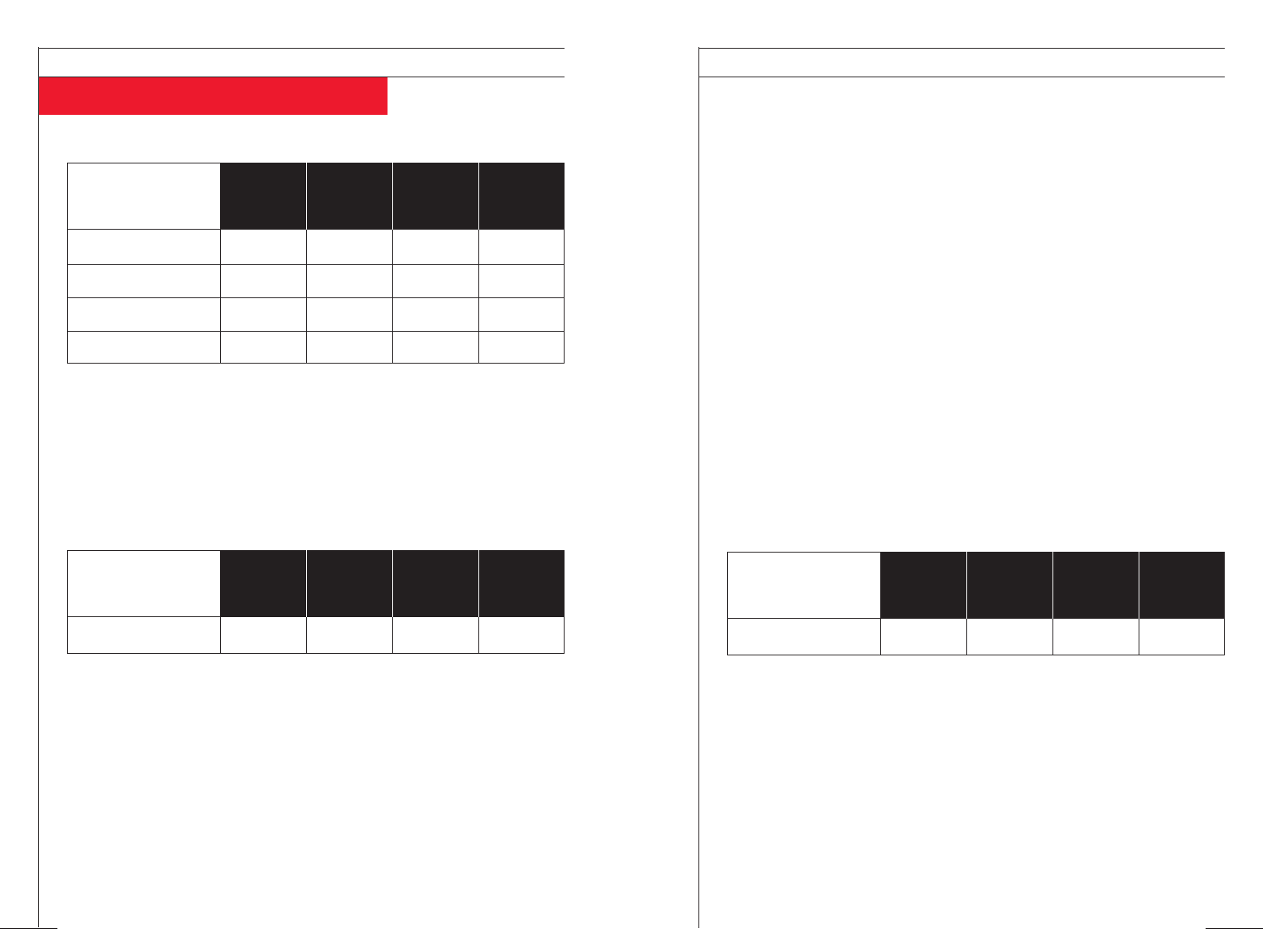
THE FOODSAVER USER MANUAL
27
Where to Recommended Vacuum Normal Storage
MEATS/FISH
Store FoodSaver Packaged Life
(without
Container Storage Life
vacuum packaging)
Beef, lamb, and pork Freezer FoodSaver Bag 2 to 3 years 6 months
Ground meat Freezer FoodSaver Bag 1 year 4 months
Poultry Freezer FoodSaver Bag 2 to 3 years 6 months
Fish Freezer FoodSaver Bag 2 years 6 months
Food Preparation and Storage Guide
THE FOODSAVER USER MANUAL
26
Where to Recommended Vacuum Normal Storage
CHEESES
Store FoodSaver Packaged Life
(without
Container Storage Life
vacuum packaging)
Cheddar, Swiss, Parmesan Refrigerator FoodSaver Bag 4 to 8 months 1 to 2 weeks
Preparation Guidelines for Meats/Fish:
Option 1: For best results pre-freeze
meats and fish for 1-2 hours before
vacuum packaging in a FoodSaver
Bag to ensure the retention of juices
and shape, and to help guarantee a
good seal.
Option 2: If it is not possible to pre-
freeze, place a folded paper towel
between the meat/fish and the end
of the bag. Leave the paper towel in
the bag when vacuum packaging to
absorb excess moisture and juices.
Preparation Guidelines for Hard Cheeses:
Keep cheese fresh even if you use
it everyday by vacuum packaging it
with the Vac 1050 after each use.
Make your original FoodSaver Bag
extra long. Simply cut along the
sealed edge, remove the cheese and
slice off the amount needed, then
place the cheese back in the bag and
repackage. Allow approximately one
inch of bag material for each time the
bag will be opened and repackaged.
Preserve Your Garden Goodness
Your FoodSaver Vac 1050 is an
invaluable tool to help preserve the
quality, freshness, and nutrients of
your homegrown vegetables. When
vacuum packaging and freezing
items from your garden, you can
enjoy your harvest year round.
General Harvesting Information
◗It is usually best to pick in the cool
of the morning because produce
has the best texture then.
◗Harvesting from a home garden
gives you the opportunity to enjoy
produce that is ripened to perfec-
tion. Because different parts of the
plant will ripen at different times,
the Vac 1050 allows you to
vacuum package small amounts
frequently and cost effectively.
◗Select top-quality young, tender
produce that is free from mold
and decay. Freezing will not
improve the quality.
◗Do not select vegetables that have
frozen in the garden to use in any
preservation method. However,
these frozen-on-the-plant vegetables
may be acceptable for immediate
fresh eating if they are harvested
before any decay starts.
◗Clean vegetables thoroughly before
freezing and vacuum packaging.
Where to Recommended Vacuum Normal Storage
LEAFY VEGETABLES
Store FoodSaver Packaged Life
(without
Container Storage Life
vacuum packaging)
Lettuce, Spinach Refrigerator Canister 2 weeks 3 to 6 days
Preparation Guidelines for Leafy Vegetables:
Wash vegetables, towel or spin dry,
and vacuum package. You can then
open the canister and take what you
need each time you make a salad.
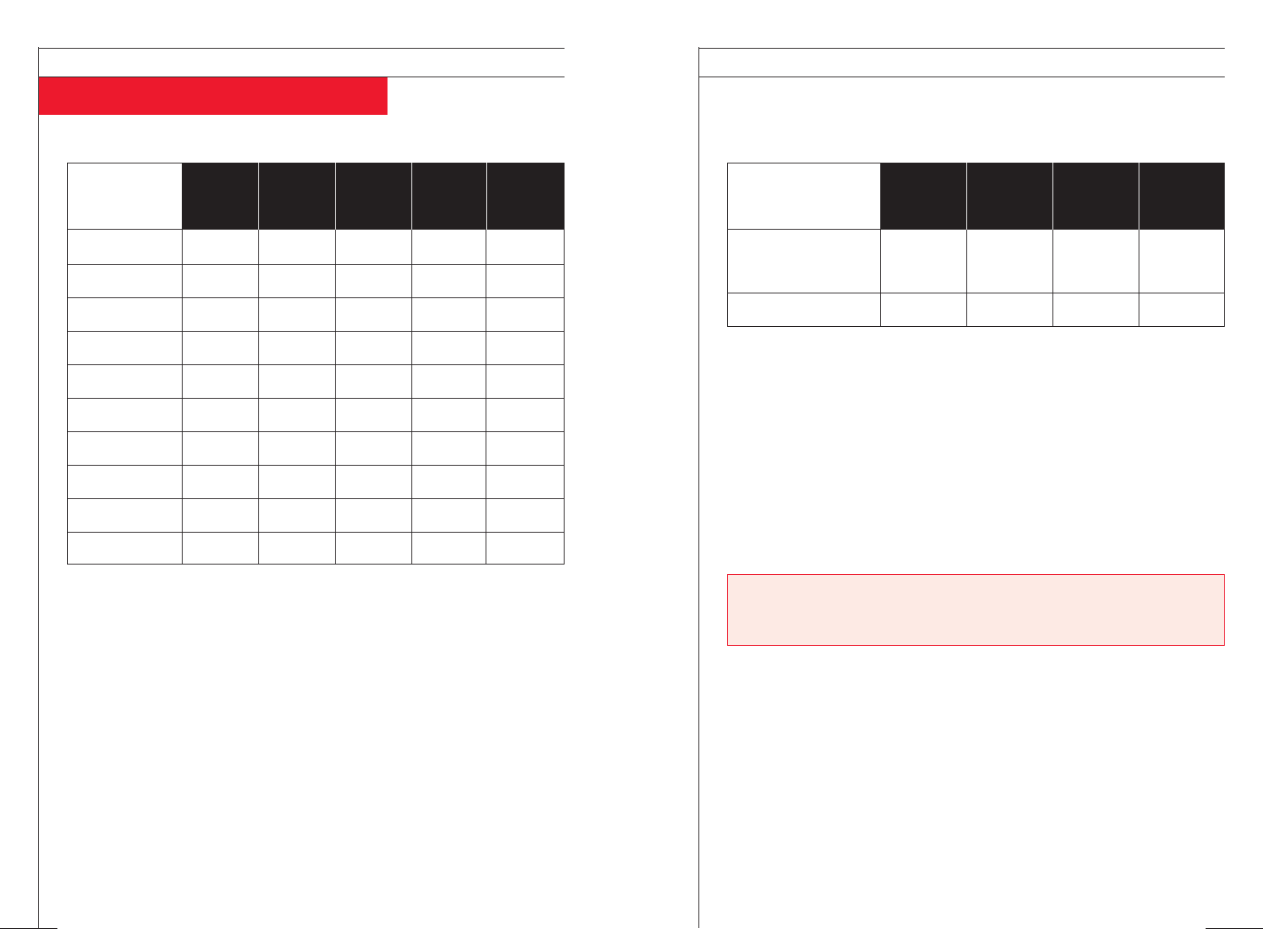
Food Preparation and Storage Guide
THE FOODSAVER USER MANUAL
29
Blanching Where to Recommended Vacuum Normal Storage
VEGETABLES
Times Store FoodSaver Packaged Life
(without
Container Storage Life
vacuum packaging)
Asparagus 11⁄2to 3 mins. Freezer FoodSaver Bag 2 to 3 years 8 months
Whole kernel corn
4 to 5 mins. Freezer FoodSaver Bag 2 to 3 years 8 months
Corn on cob 6 to 11 mins. Freezer FoodSaver Bag 2 to 3 years 8 months
Snow peas 11⁄2to 2 mins. Freezer FoodSaver Bag 2 to 3 years 8 months
Sugar snap peas 11⁄2to 2 mins. Freezer FoodSaver Bag 2 to 3 years 8 months
Green beans 3 mins. Freezer FoodSaver Bag 2 to 3 years 8 months
Broccoli 3 to 4 mins. Freezer FoodSaver Bag 2 to 3 years 8 months
Brussels sprouts 3 to 5 mins. Freezer FoodSaver Bag 2 to 3 years 8 months
Cabbage 3 to 5 mins. Freezer FoodSaver Bag 2 to 3 years 8 months
Cauliflower 3 to 4 mins. Freezer FoodSaver Bag 2 to 3 years 8 months
THE FOODSAVER USER MANUAL
28
Preparation Guidelines for Vegetables:
◗Vegetables should be blanched
before vacuum packaging. This
stops the enzyme action, which
will eventually cause loss of flavor,
color, and texture.
◗Blanch vegetables by placing them
in boiling water or in the micro-
wave until they are cooked but
still crisp. Immerse in cold water
to stop the cooking process. Dry
vegetables on a towel, then freeze.
◗To freeze vegetables in individual
servings, place them on baking
sheets and spread out so that pieces
are not touching. This way they
will not freeze together in a block.
◗Place baking sheet in the freezer
for 1-2 hours until the pieces are
solidly frozen.
◗Vacuum package in a FoodSaver
Bag and return to the freezer for
long-term storage. Remember, you
can microwave and boil FoodSaver
Bags right from the freezer.
◗Strong-smelling vegetables emit
gases during storage. Therefore, they
must be stored in the freezer only.
Where to Recommended Vacuum Normal Storage
FRUITS
Store FoodSaver Packaged Life
(without
Container Storage Life
vacuum packaging)
Apricots, Nectarines,
Peaches, Plums, Freezer FoodSaver Bag 1 to 3 years 6 to 12 months
All types of berries
All types of berries Refrigerator Canister 1 to 2 weeks* 1 to 6 days
*NOTE: Blueberries and cranberries will usually last about two weeks and softer
berries such as boysenberries, blackberries, raspberries, and strawberries can
be stored for approximately one week.
Preparation Guidelines for Fruits:
For best results, before vacuum pack-
aging soft fruits or berries in a
FoodSaver Bag, pre-freeze for 1-2
hours or until solidly frozen. To
freeze fruits in individual servings,
place sliced fruit or berries on a
baking sheet and spread out so the
pieces are not touching. This way
they will not freeze together in a
block. Then vacuum package in
portions for baking, or in your
favorite combinations for easy fruit
salad all year round.
Keep berries fresh longer in the
refrigerator by repackaging them in
a FoodSaver Canister. You can open
the canister and take what you need
for snacks or fruit salad, then reseal
to maintain freshness.
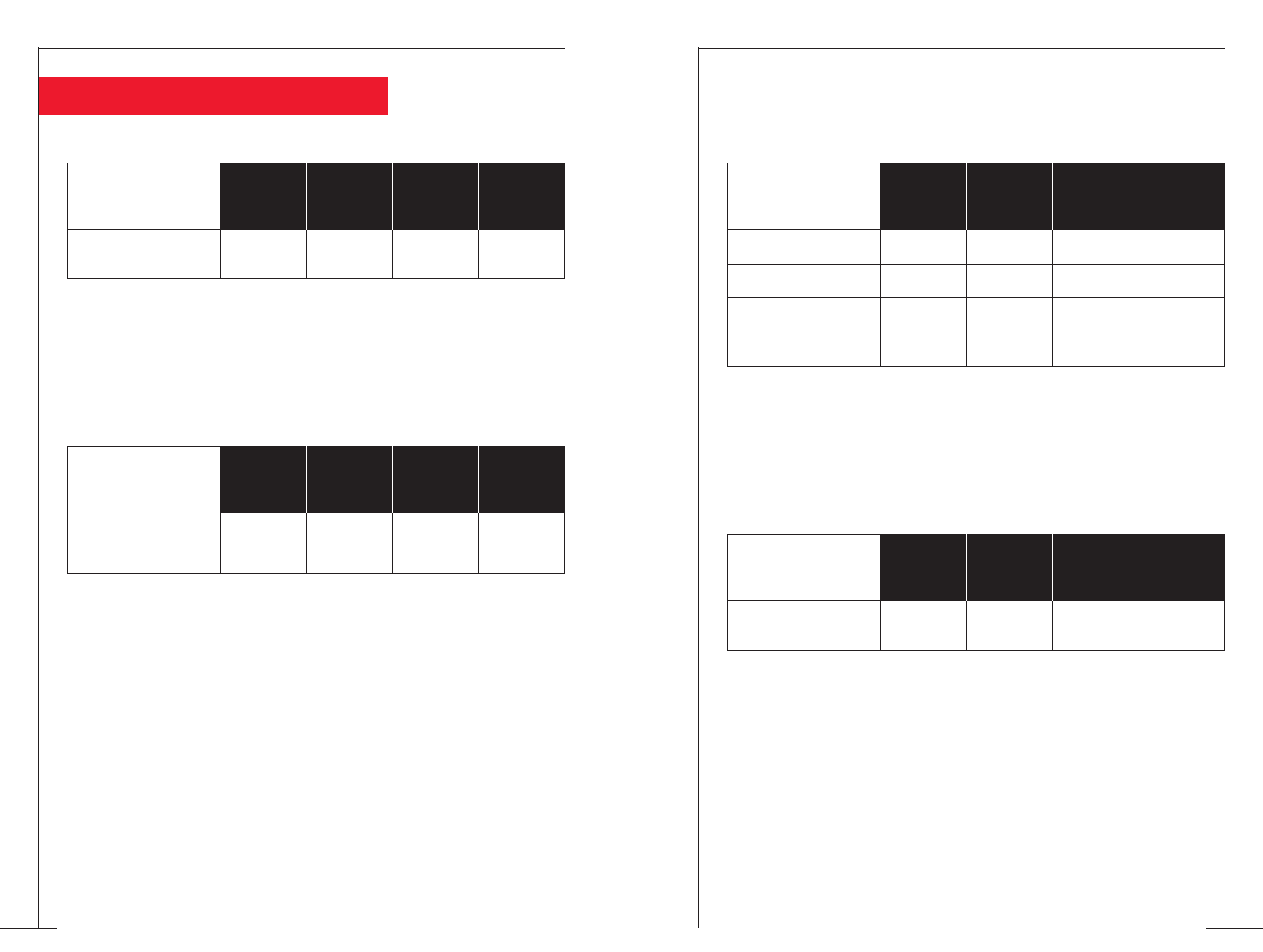
THE FOODSAVER USER MANUAL
31
Food Preparation and Storage Guide
THE FOODSAVER USER MANUAL
30
Where to Recommended Vacuum Normal Storage
BAKED GOODS
Store FoodSaver Packaged Life
(without
Container Storage Life
vacuum packaging)
Bread/rolls, Freezer FoodSaver Bag 1 to 3 years 6 to 12 months
Bagels/pastries
Where to Recommended Vacuum Normal Storage
NUTS
Store FoodSaver Packaged Life
(without
Container Storage Life
vacuum packaging)
Walnuts, Pistachios,
Almonds, Peanuts, Pantry FoodSaver Bag, 2 years 6 months
Sunflower seeds Canister
Preparation Guidelines for Baked Goods:
Before vacuum packaging soft or airy
baked goods, pre-freeze for 1-2 hours
or until solidly frozen so that they
will hold their shape. You can bake a
double batch of bread or multiple pie
shells and vacuum package the extras
for later use. Also, you can vacuum
package treats such as peanut brittle
and fudge to send as gifts.
Preparation Guidelines for Nuts:
Vacuum packaging eliminates the
stale or rancid flavor nuts often get
when stored. Plus, it eliminates the
growth of molds that commonly
occur with nuts. Keep nuts fresh by
vacuum packaging them with the
Vac 1050. You can open the con-
tainer and take what you need for
baking or snacks and then repack-
age it. If using a FoodSaver Bag,
allow approximately one inch of
extra bag material for each time the
bag will be opened and repackaged.
Where to Recommended Vacuum Normal Storage
PREPARED LIQUIDS
Store FoodSaver Packaged Life
(without
Container Storage Life
vacuum packaging)
Soups, Stews,
Sauces, Other liquids Freezer FoodSaver Bag 1 to 2 years 3 to 6 months
Where to Recommended Vacuum Normal Storage
COFFEE
Store FoodSaver Packaged Life
(without
Container Storage Life
vacuum packaging)
Beans Freezer FoodSaver Bag 2 to 3 years 6 to 9 months
Ground Freezer FoodSaver Bag 2 years 6 months
Beans Pantry FoodSaver Bag, 1 year 3 months
Canister
Ground Pantry Canister 5 to 6 months 1 month
Preparation Guidelines for Coffee:
When vacuum packaging ground
coffee in a FoodSaver Bag, leave
coffee in the original bag or place
into a regular plastic bag and then
place that bag into a FoodSaver Bag
for vacuum packaging. This will
prevent grounds from being drawn
into the vacuum pump and helps
guarantee a good seal.
Preparation Guidelines for Prepared Liquids:
To vacuum package liquids for freezer
storage, pre-freeze them first in a cas-
serole or loaf pan until they are solid.
Remove from the pan and vacuum
package in a FoodSaver Bag. These
“frozen bricks” stack conveniently in
your freezer and can go right into
boiling water or the microwave when
you are ready to use them. This same
technique can be used for pre-cooked
dinners and leftovers.
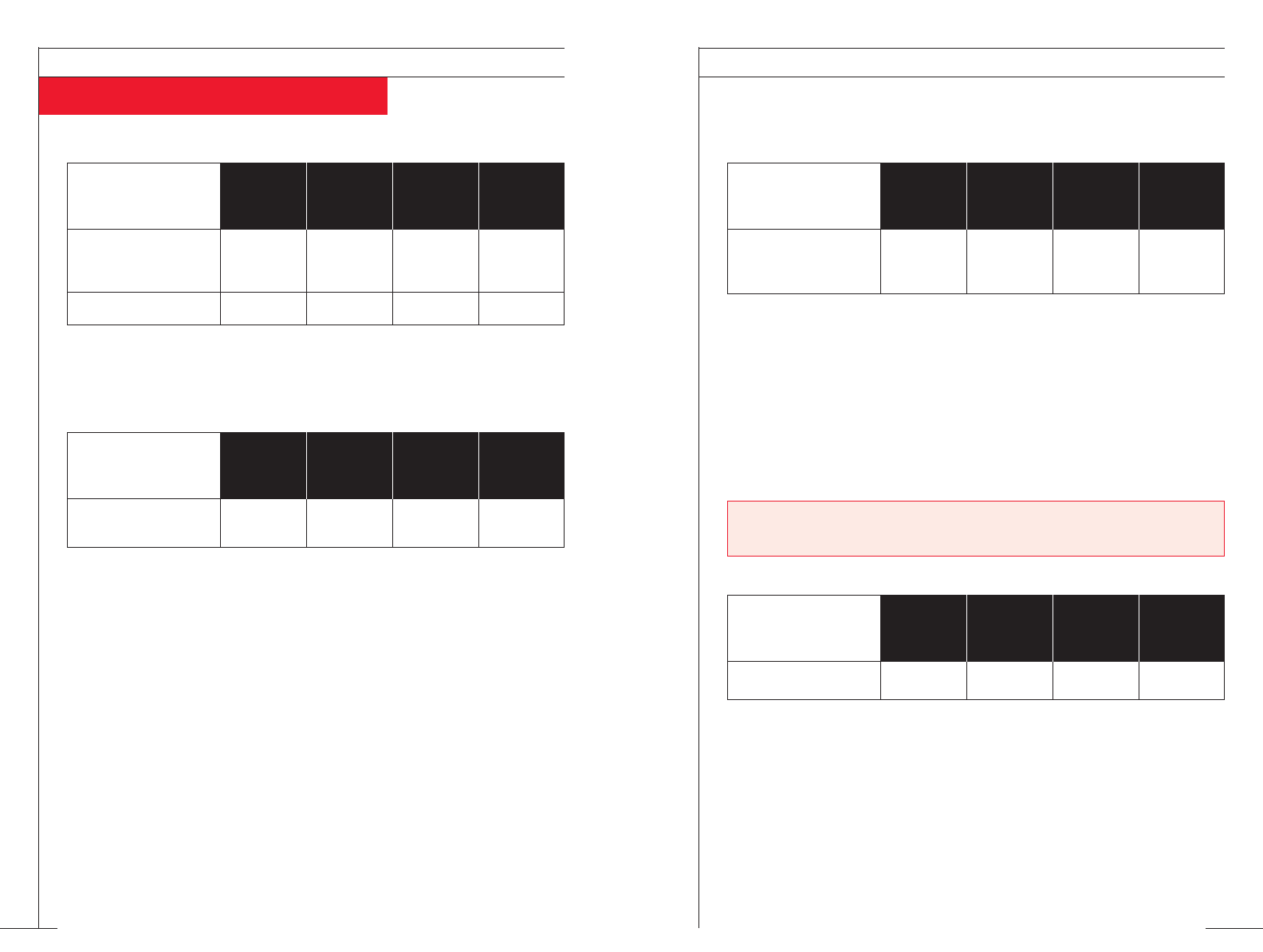
THE FOODSAVER USER MANUAL
33
Where to Recommended Vacuum Normal Storage
BOTTLED LIQUIDS
Store FoodSaver Packaged Life
(without
Container Storage Life
vacuum packaging)
Oils (with no preservatives
such as safflower, canola, Pantry Bottle Stopper 1 to 11⁄2years 5 to 6 months
corn oil)
Wine Refrigerator Bottle Stopper 2 to 4 months 1 to 3 weeks
Where to Recommended Vacuum Normal Storage
DRY FOODS
Store FoodSaver Packaged Life
(without
Container Storage Life
vacuum packaging)
Rice/risotto, Pasta, FoodSaver Bag,
Beans, Grains Pantry Canister 1 to 2 years 6 months
Food Preparation and Storage Guide
THE FOODSAVER USER MANUAL
32
Preparation Guidelines for Bottled Liquids:
Leave at least one inch of room
between the contents and the
bottom of the bottle stopper before
vacuum packaging bottled liquids.
Preparation Guidelines for Dry Foods:
Before vacuum packaging dry foods
with sharp edges in a FoodSaver
bag, such as rice and pasta, wrap the
food in cushioning material, like a
paper towel. This will help protect
the FoodSaver Bag from punctures.
Where to Recommended Vacuum Normal Storage
SNACK FOODS
Store FoodSaver Packaged Life
(without
Container Storage Life
vacuum packaging)
Crackers, chips, cookies Pantry Canister 3 to 6 weeks 1 to 2 weeks
Where to Recommended Vacuum Normal Storage
POWDERY FOODS
Store FoodSaver Packaged Life
(without
Container Storage Life
vacuum packaging)
Flour/sugar, Dry milk,
Brown sugar, Pantry FoodSaver Bag, 1 to 2 years 6 months
Dried coconut Canister
Preparation Guidelines for Powdery Foods:
For best results when vacuum pack-
aging powdery foods in a FoodSaver
Bag, leave the item in its original
bag, then place that bag inside a
FoodSaver Bag. This keeps fine or
powdery food from being drawn
into the vacuum pump and helps to
guarantee a good seal.
Keep powdery foods fresh and pro-
tect them from insect infestation by
repackaging them with the Vac
1050 after each use. You can open
the container and take what you
need for baking or cooking.
Preparation Guidelines for Snack Foods:
Keep snack foods fresh even if you
use them everyday by vacuum pack-
aging them with the Vac 1050.
Open the canister, take what you
need, then repackage it to maintain
freshness.
NOTE: Placing a box inside a FoodSaver Bag may puncture the bag. Therefore, it
is best to use the inner bag in which most powdery foods are generally packaged.

Important Safeguards
THE FOODSAVER USER MANUAL
34
Troubleshooting
THE FOODSAVER USER MANUAL
35
For Your Own Safety, Always Follow These Basic Safety
Precautions When Using the FoodSaver Vac 1050:
1Read the instructions carefully.
2Do not use the Vac 1050 on wet or hot surfaces, or near a heat
source.
3Do not immerse any part of the Vac 1050, power cord or plug
into water or other liquid.
4To disconnect, unplug the power cord from the electrical outlet.
Do not disconnect by pulling on the cord.
5Do not operate the Vac 1050 with a damaged power cord or
plug. Do not operate the Vac 1050 if it malfunctions or is in any
way damaged. If the cord or the machine is damaged, it must be
returned to an authorized service center.
6Do not use an extension cord with the FoodSaver 1050.
7Use only accessories or attachments recommended by Tilia, Inc.
8Use the Vac 1050 only for its intended use.
9Closely supervise children when using any electrical appliance.
Do not allow the Vac 1050 to be used as a toy.
10 120v Machines Only: The Vac 1050 has a polarized plug (one
blade is wider than the other). To reduce the risk of electrical
shock, this plug is intended to fit in a polarized outlet only one
way. If the plug does not fit fully in the outlet, reverse the plug.
If it still does not fit, contact a qualified electrician. Do not
modify the plug in any way.
Nothing Happens When the On Button Is Pressed:
1Make sure the power cord is firmly plugged into the electrical outlet.
2Make sure the power cord is not damaged in any way.
3Make sure the electrical outlet is operative by plugging in
another appliance.
4Wait 20 minutes to allow the Vac 1050 to cool off, and then try
using it again. The Vac 1050 will shut off automatically if it
becomes too hot. To keep the machine from becoming too hot:
a. Wait at least 20 seconds for the machine to cool down after
vacuum packaging and/or sealing before attempting to vacuum
and/or seal another bag.
b. Keep the lid open before vacuuming and/or sealing another bag.
Air Is Not Removed From the Bag:
1Make sure the open end of the bag is resting entirely inside the
vacuum channel. Make sure you are not putting the edge of the
bag beyond the vacuum channel.
2Check the bag for leaks. Seal the bag with some air in it. Submerge
it in water and apply pressure. Bubbles indicate a leak. If the bag
has a leak, you need to use a new bag.
3If using a custom-sized FoodSaver Bag, check the seal of the bag.
There may be a wrinkle in the bag along the seal, which causes
leakage and prevents air from being removed. Cut the bag and
reseal the edge.
4Do not attempt to make your own side seams for a FoodSaver
Bag. They are manufactured with special side seams, which are
sealed all the way to the outer edge. Making your own side seams
may leave air pockets, which will cause leakage and prevent air
from being completely removed.

THE FOODSAVER USER MANUAL
37
Troubleshooting
THE FOODSAVER USER MANUAL
36
The Mason Jar or FoodSaver Canister Will Not Vacuum:
1Make sure the jar sealer is centered and pressed firmly over the lid
on the mason jar.
2Make sure the rubber gasket on the canister/mason jar lid is free
from food materials, crumbs, etc.
3Make sure the rim of the canister or mason jar does not have any
cracks or scratches. Any gaps can prevent a vacuum from forming.
4Make sure you aren’t filling the canister or mason jar too full
prior to vacuum packaging. Always leave at least one inch (1")
between the contents and the lid.
5Make sure the metal lid of the mason jar is not bent.
The FoodSaver Universal Lid Will Not Vacuum:
1Make sure that the rim of the container is smooth and flat.
Ragged edges will prevent a vacuum from forming.
2Make sure the rubber gasket underneath the universal lid and the
rim of the container are free from food materials, crumbs, etc.
3Make sure the knob on the universal lid is closing and opening
properly and that there are no food materials caught inside.
The FoodSaver Bottle Stopper Will Not Vacuum:
1Make sure the bottle stopper is fitting snugly inside the bottle. If
it is loose, air may leak in and prevent a vacuum from forming.
2Make sure the neck of the bottle and tip of the hose attachment
are free from food materials, crumbs, etc. Any gaps will prevent a
vacuum from forming.
If You Cannot Fix the Problem:
Call our Consumer Services Department at the number listed at
the back of this manual.
Air Was Removed From the Bag, But Has Come Back
Into the Bag:
1Check the seal of the bag. There may be a wrinkle in the bag along
the seal, which caused leakage and allowed air to come back into
the bag. Cut the bag open, and vacuum package it again.
2Moisture or food material (i.e. juices, grease, crumbs, powders, etc.)
along the seal may have caused leakage and allowed air to come
back into the bag. Cut the bag open, wipe the top inside of the bag
material to clear away any moisture or food residue, then vacuum
package the bag again. See the “Food Preparation and Storage
Guide” in this User Manual for guidelines for specific foods.
3Food items with sharp edges may have punctured the bag. If you
find a puncture hole, you will need to use a new FoodSaver Bag.
Make sure to protect the bag from puncture holes by wrapping
the items in cushioning material such as a paper towel.
4If you find none of these conditions identified in 1-3 (above), and the
bag appears to have air inside, fermentation or the release of natural
gases from inside the foods may have occurred. This could indicate
that the food may have begun to spoil and should be discarded.
The Bag Melts:
1The sealing strip may have become too hot. Always wait at least
20 seconds for the Vac 1050 to cool down before vacuuming
and/or sealing another bag.
The Bag Will Not Seal:
1Wait 20 minutes to allow the Vac 1050 to cool off, then try using
it again. The Vac 1050 will shut off automatically if it is becomes
too hot. To help prevent the machine from becoming too hot:
a. Wait at least 20 seconds for the machine to cool down after
vacuum packaging and/or sealing before attempting to vacuum
and/or seal another bag.
b. Keep the lid open before vacuuming and/or sealing another bag.
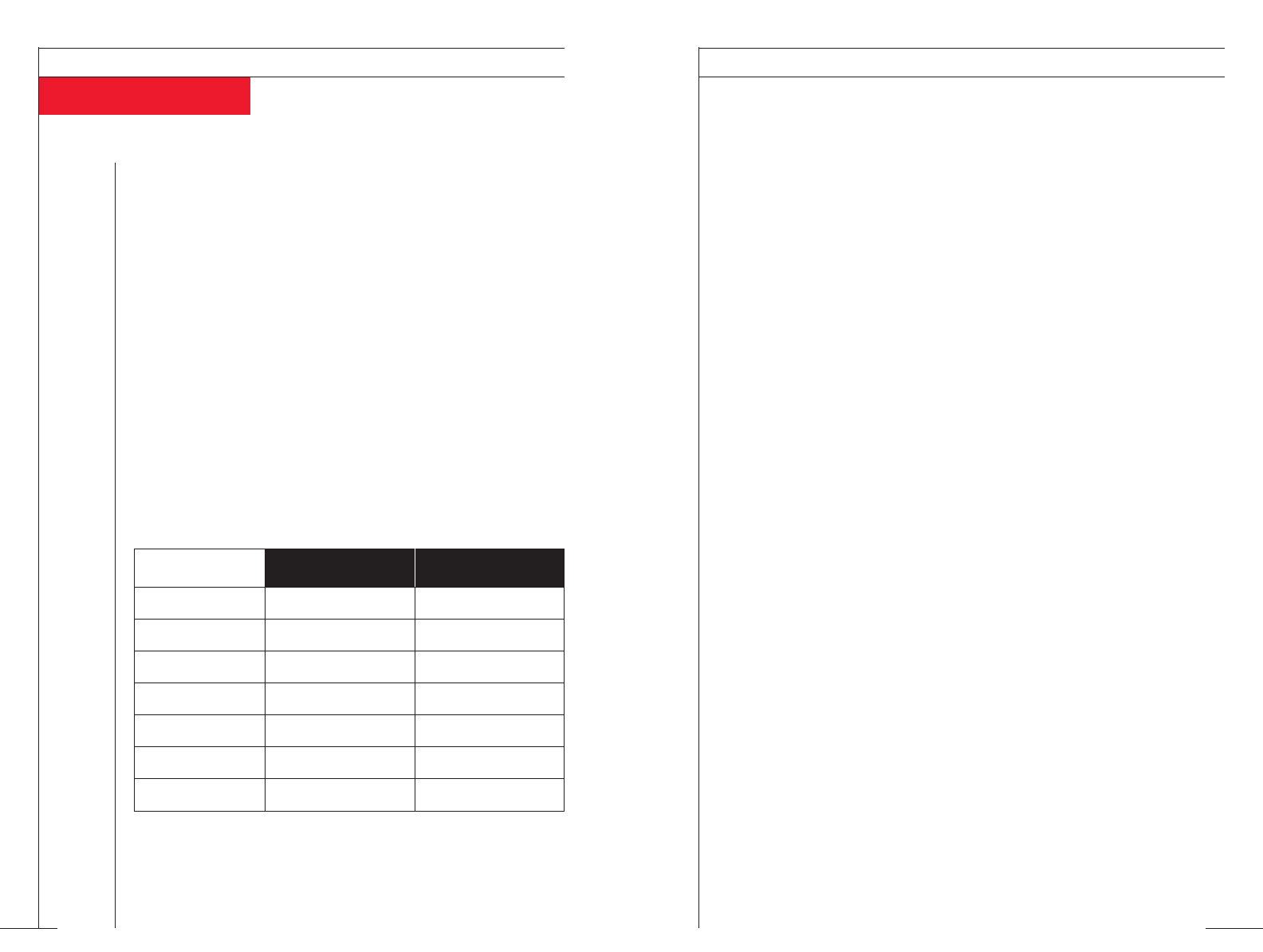
THE FOODSAVER USER MANUAL
39
Broiling/Grilling Baking
Pork Closest to heat source. Not recommended
12 mins. per inch – turn once.
Beef Closest to heat source. Not recommended
10 mins. per inch – turn once.
Shrimp Closest to heat source. Bake at 400˚ for
3-4 mins. per side. 6-10 mins.
Fish Furthest from heat source. Bake at 400˚ for
4-5 mins. per side. 6-10 mins. per inch
Poultry with bone Closest to heat source. Bake at 350˚ for
4-5 mins. per side. 8-10 mins.
Poultry without bone Closest to heat source. Bake at 350˚ for
12-14 mins. 8-10 mins.
Vegetables Closest to heat source. Not recommended
Time varies – see recipes.
Marinating Recipes
THE FOODSAVER USER MANUAL
38
Spicy Citrus Marinated Chicken
Serves 4
Ingredients needed:
11⁄4to 11⁄2lbs. boneless, skinless chicken thighs
2 tablespoons each lemon, lime, orange juice
1 tablespoon olive oil
1 teaspoon cumin
1 teaspoon chili powder
1 teaspoon crushed garlic
11⁄2teaspoons minced jalapeño peppers
Place chicken thighs in FoodSaver Canister. Combine remaining ingredients.
Pour over chicken thighs. Vacuum package. Marinate for 15-20 minutes
in the refrigerator.
Remove chicken from the canister and broil, grill, or bake. See cooking
chart for times.
Yogurt Marinated Chicken
Serves 4
Ingredients needed:
2 large chicken breasts – split (about 8 oz. each)
1 tablespoon olive oil
2 teaspoons cumin
2 teaspoons coriander
2 teaspoons paprika
1⁄4cup minced onion
2 tablespoons lime juice
1⁄2cup plain yogurt
1⁄4teaspoon salt
Heat oil in small saucepan and add cumin, coriander, and paprika. Cook
for a minute or two until aromatic. Remove from heat and add rest of
ingredients. Let cool completely. Place chicken breasts in FoodSaver
Canister. Pour marinade over chicken breasts. Vacuum package. Marinate
15-20 minutes in the refrigerator.
Remove chicken from the canister and broil, grill, or bake. See cooking
chart for times.
You can marinate in a fraction of the usual time with FoodSaver
Canisters. What usually takes hours to marinate takes only about
20 minutes when you vacuum package your food. All FoodSaver
Canisters work for marinating, but we recommend the Square
FoodSaver Canister because less marinade will be needed.
IMPORTANT:
1Do not attempt to vacuum package any contents that are warmer
than room temperature since the vacuum may cause the contents
to bubble out of the container.
2Leave at least one inch between the top of the contents and the
canister rim.
3The Square and Bulk Storage Canister bases can be used in
the microwave to reheat food. However, do not put lids in the
microwave. Also, do not put either part of the FoodSaver Designer
Canisters in the microwave.

THE FOODSAVER USER MANUAL
41
Marinating Recipes
THE FOODSAVER USER MANUAL
40
Indonesian Marinated Flank Steak
Serves 4-6
Ingredients needed:
11⁄2to 12⁄3lbs. flank steak
2 tablespoons chunky peanut butter
3 tablespoons light soy sauce
2 tablespoons lime juice
2 tablespoons orange juice
11⁄2teaspoons grated fresh ginger
Place flank steak in a FoodSaver Canister. Combine remaining ingredients.
Pour over flank steak. Vacuum package. Marinate 15-20 minutes in
the refrigerator.
Remove steak from canister and broil or grill. See cooking chart for times.
Smoked Salmon
Serves 4-6
Ingredients needed:
21⁄2lbs. fresh salmon filet
1 quart water (or enough to cover the salmon)
1 cup firmly packed dark brown sugar
1⁄4cup salt – should be salty to taste
2 bay leaves
1 tablespoon fresh grated ginger
6 whole allspice cloves crushed
Honey to taste
In a 2-quart sauce pan combine water, brown sugar, salt, bay leaves, ginger,
and allspice. Bring to rapid boil; stir until brown sugar is dissolved. Remove
from heat. Let cool completely. In a FoodSaver Canister, place filet of
salmon skin down. Poor cooled brine liquid over salmon to cover.
Vacuum package and refrigerate for approximately 4 hours. Remove salmon
from canister and discard brine liquid. Rinse salmon thoroughly. Pat dry.
Spread a layer of honey over flesh side of salmon. Sprinkle with coarsely
ground pepper. Salmon is now ready to be smoked to desired consistency.
(Note: This recipe also works well with trout.)
Pork New Orleans
Serves 4
Ingredients needed:
11⁄2lbs. pork sirloin
1⁄2cup strong coffee
1⁄4cup molasses
1⁄4cup balsamic or red wine vinegar
2 tablespoons Dijon mustard
1⁄8teaspoon cayenne pepper
1⁄4teaspoon salt
Place pork sirloin in FoodSaver Canister. Combine all ingredients and
pour over pork sirloin. Vacuum package. Marinate 15-20 minutes in the
refrigerator.
Remove pork from the canister and broil or grill. See cooking chart for times.
Steak Provençal
Serves 4-6
Ingredients needed:
11⁄2lbs. top sirloin steak
1 tablespoon Dijon mustard
1 tablespoon coarse mustard
2 tablespoons red wine
2 tablespoons balsamic vinegar
11⁄2tablespoons dry thyme, crumbled
1⁄2teaspoon coarse black pepper
3 large garlic cloves
Combine all ingredients and place in FoodSaver Canister. Vacuum pack-
age. Marinate 15-20 minutes in the refrigerator.
Remove steak from the canister and broil or grill. See cooking chart
for times.

Vacuum Packaging Non-Food Items
THE FOODSAVER USER MANUAL
43
Your FoodSaver Vac 1050 also pro-
tects non-food items from oxidation,
corrosion, and moisture. Just follow
the directions for vacuum packaging
using the FoodSaver Bags or acces-
sories.
◗Vacuum package your silver.
Without exposure to air, the silver
will not tarnish. Be sure to cover
fork tines in something cushion-
ing like a paper towel, so they
won’t puncture the bag.
◗Vacuum package your children’s
clay, so that it won’t dry out and
get cracked.
◗Camping and hiking gear stays
dry and compact. Vacuum pack-
aging your clothes and equipment
will help save space in your pack.
Vacuum package matches, maps,
and anything you want to stay dry.
◗For picnics, fill a FoodSaver Bag
with ice and seal. When it melts,
you’ll have fresh water for drink-
ing or you can put it back in the
freezer as a reusable ice pack.
◗Vacuum package your food and
equipment for a boating or sailing
outing. Food will stay dry in the
cooler, batteries and film won’t get
damaged by water, and you’ll appre-
ciate having a dry change of clothes.
◗FoodSaver Bags are also great for
storing extra keys or any spare parts
you need for your boat. They will
be dry and in one place.
◗Vacuum package first aid kits and
emergency kits for your house,
your boat, and your car. Items will
all be in one package and will stay
dry and without dirt and mold.
Include flares, batteries, flashlight,
candles, and matches.
◗Vacuum package extra spark plugs
and precision tools that always
seem to get lost. Seal nuts, bolts,
and screws by size in separate bags.
◗Keep the leftover oil from deep
fryers from turning rancid. After the
oil has cooled down, strain it into
mason jars or FoodSaver Canisters
and vacuum package.
Marinating Recipes
THE FOODSAVER USER MANUAL
42
Salsa Marinated Shrimp
Serves 4-6
Ingredients needed:
11⁄4lbs. shrimp, cleaned and de-veined
2 tablespoons minced red onion
6 cloves of garlic pressed or minced
4 tablespoons lime juice
1 large tomato chopped (about 3⁄4cup)
4 tablespoons olive oil
1⁄2cup minced cilantro
In FoodSaver Canister, combine onion, garlic, lime juice, and tomato until
smooth. Slowly add oil until completely combined, then add cilantro.
Salt to taste. Add shrimp to canister. Vacuum package. Marinate 15-20
minutes in the refrigerator.
Remove the shrimp from the canister and broil or grill. See cooking chart
for time. (Easiest to cook if skewered.)
Mixed Marinated Vegetables
Serves 4
Ingredients needed:
1 lb. assorted squash (green zucchini, yellow crookneck, summer
squash, patty pan squash)
1 large bell pepper
1 tablespoon balsamic or red wine vinegar
1 tablespoon basil
1 tablespoon dried thyme (crumbled)
1 teaspoon Dijon mustard
1 tablespoon olive oil
Cut squash into 1⁄4" slices. Cut bell pepper into 1" strips. Combine all
ingredients in a FoodSaver Canister. Vacuum package. Marinate 15-20
minutes in the refrigerator.
If using an oven, lay vegetables in a single layer on a baking sheet and
broil 3-4 minutes on each side closest to the heat source. Follow the same
instructions for grilling as for broiling. Serve hot or at room temperature.

THE FOODSAVER USER MANUAL
45
of law, including, but not limited
to any implied warranties of
merchantability or fitness for a
particular purpose. This warranty
does not cover or provide for the
reimbursement or payment of in-
cidental or consequential dam-
ages. Some states do not allow this
exclusion or limitation of incidental
or consequential damages so the
above limitation or exclusion may
not apply to you.
Legal Remedies
This warranty gives you specific
legal rights. You may also have other
rights which vary from state to state.
This warranty is void outside North
America (the United States, its
possessions, Canada, and Mexico).
Procedure for Obtaining
Performance Warranty
Before you return your product for
warranty repair, call Tilia’s Consumer
Services Department listed below
for complete shipping instructions
and a Return Authorization (RA)
number. Any product returned for
warranty repair must be delivered
freight prepaid in either its original
packaging or packaging affording an
equal degree of protection.
IF YOU NEED SERVICE
If you have any questions concerning service of this product, please contact:
Evidence of original purchase is required, so it is important to hold onto
your sales receipt or packing slip.
Tilia, Inc.
P.O. Box 194530
San Francisco, CA 94119-4530
www.foodsaver.com
cust_service@tilia.com
Toll-Free Consumer
Services Support
United States: 1-800-777-5452
Canada: 1-877-804-5383
Warranty and Service Information
THE FOODSAVER USER MANUAL
44
The following warranty policy
applies only to the original con-
sumer of this product and is not
transferable. Evidence of original
purchase is required for warranty
service (this could be the sales
receipt or packing slip, etc).
Elements of Warranty
Tilia, Inc. (“Tilia”) warrants, for one
year from the date of purchase, to
the original consumer, this product
to be free from defects in materials
and workmanship under intended
normal use subject only to the limi-
tations and exclusions set out below.
Warranty Limitation and Duration
This warranty to the original con-
sumer shall terminate and be of no
further effect 12 months after the
date of the original purchase. This
warranty is invalid if this product is:
a. Used for commercial or rental
purposes;
b. Damaged or carelessly or improp-
erly maintained, misused, abused,
or is not operated in accordance
with the operating instructions as
explained in the User Manual.
c. Serviced or repaired by persons
other than those authorized by
Tilia, Inc.
d. Modified, aligned, altered, or
tampered with.
e. Damaged due to natural disas-
ters including but not limited to
lightning or power surges.
f. Used in any conjunction with
equipment or parts or as part of
any System not manufactured
by Tilia.
Statement of Remedy
In the event the product does not
conform to this warranty at any
time while this warranty is in effect,
Tilia will repair or replace the
product (at Tilia’s option) and return
it to you without charge for parts,
services, or any other cost (except
shipping and handling) incurred by
Tilia or its representative in connec-
tion with the performance of this
warranty. The limited warranty set
forth above is the sole and entire
warranty pertaining to the product
and is in lieu of and excludes all
other warranties of any nature
whatsoever, whether express,
implied, or arising by operation
ONE-YEAR LIMITED WARRANTY

©2000 by Tilia, Inc. All Rights Reserved.
This material may not be copied or reproduced in any
fashion without written permission from the publisher.
FoodSaver®is a registered trademark of Tilia, Inc.
First printing, August 2000
Printed in the United States of America
FoodSaver Patent 4,941,310
FoodSaver Bag Patent RE: 34,929
Item# 18-0509 (10/00)
User Manual
The Original Home Vacuum Packaging System
™
Vac 1050